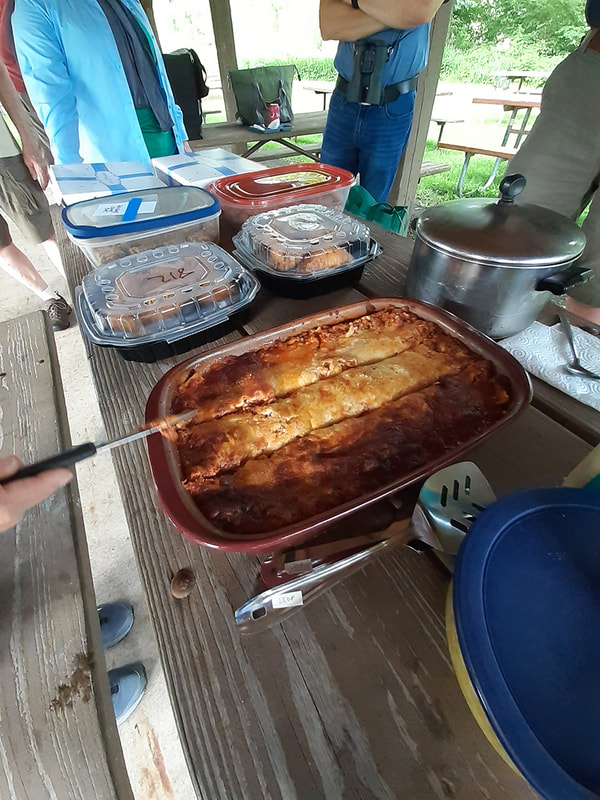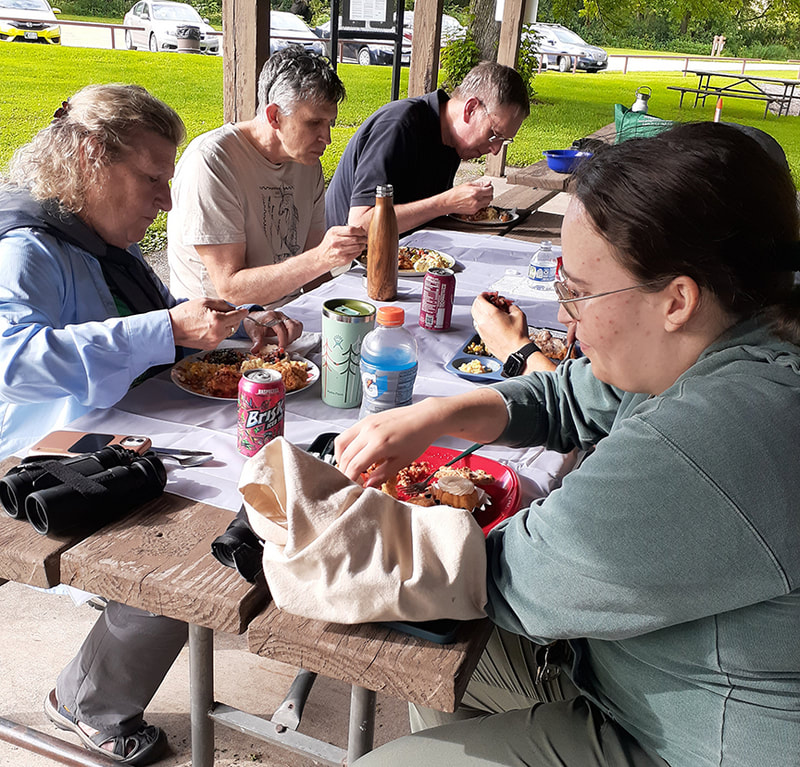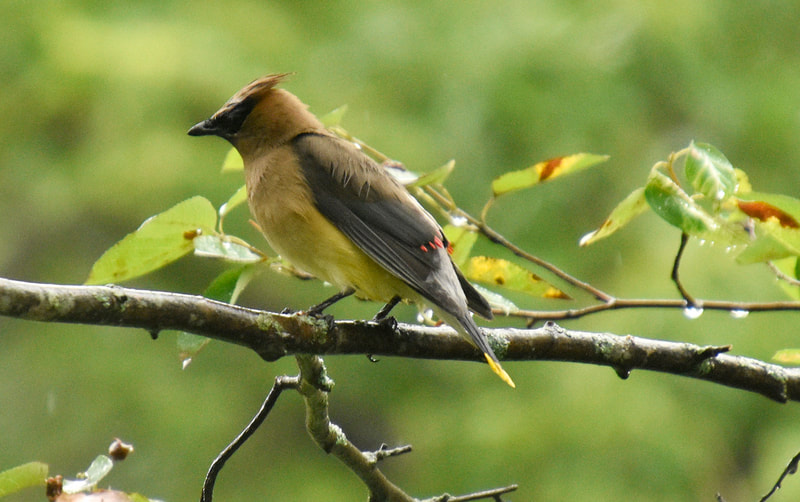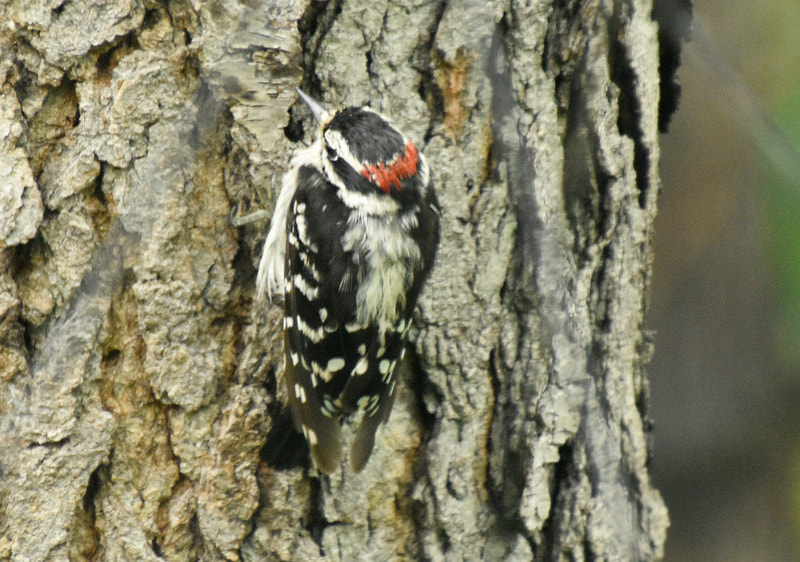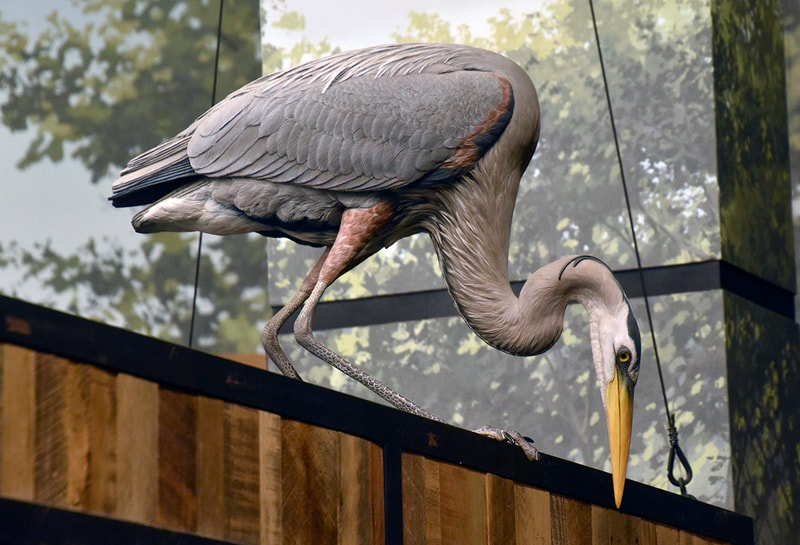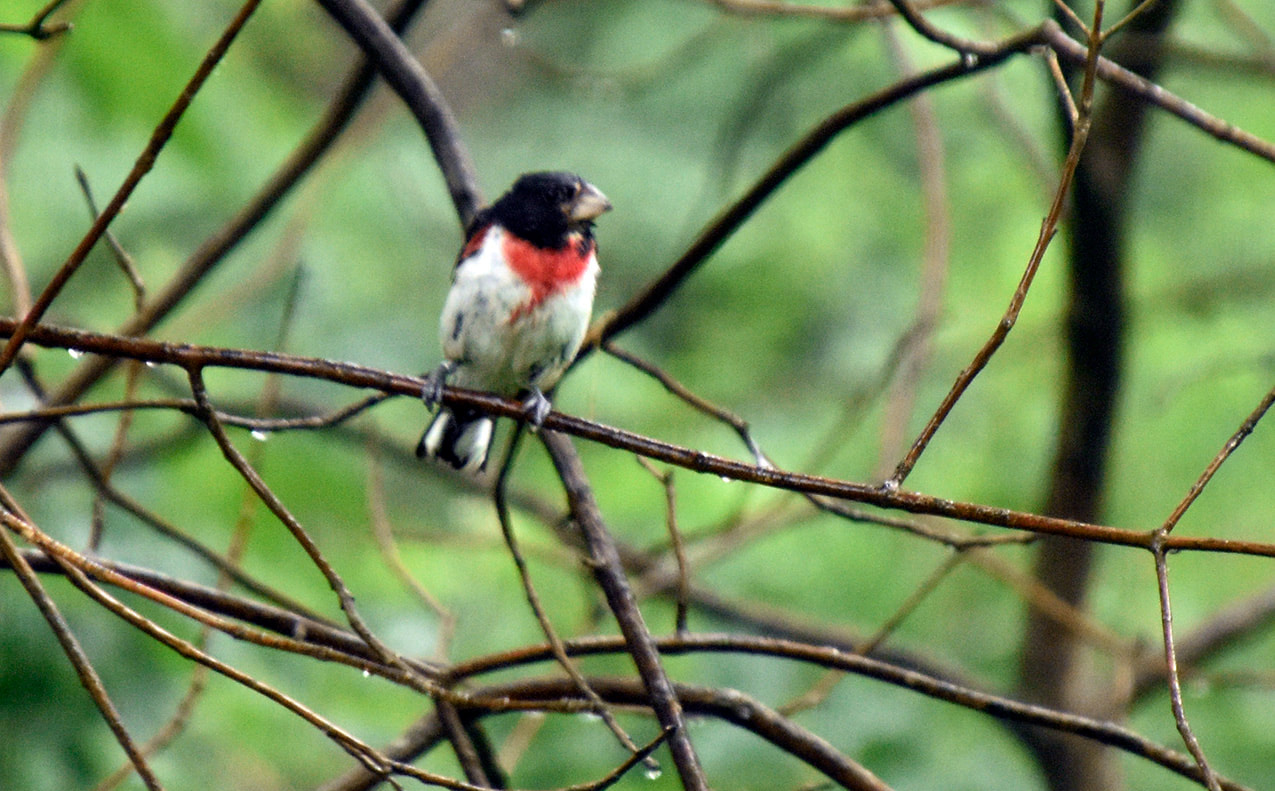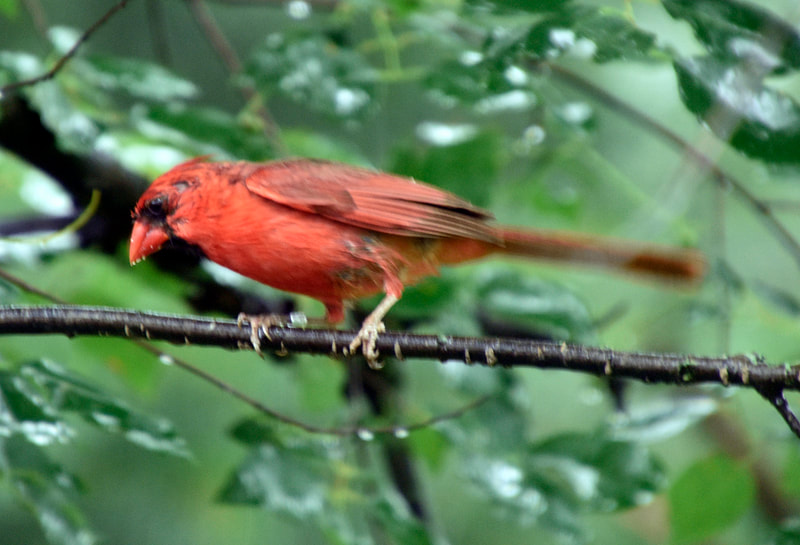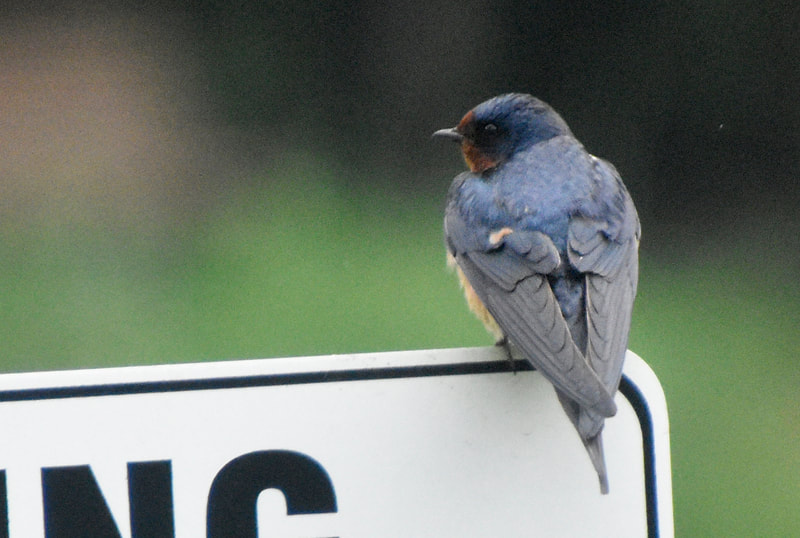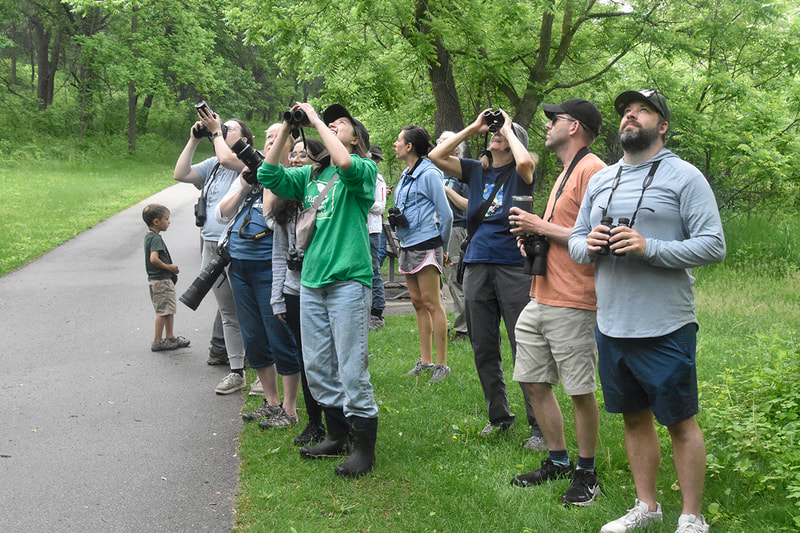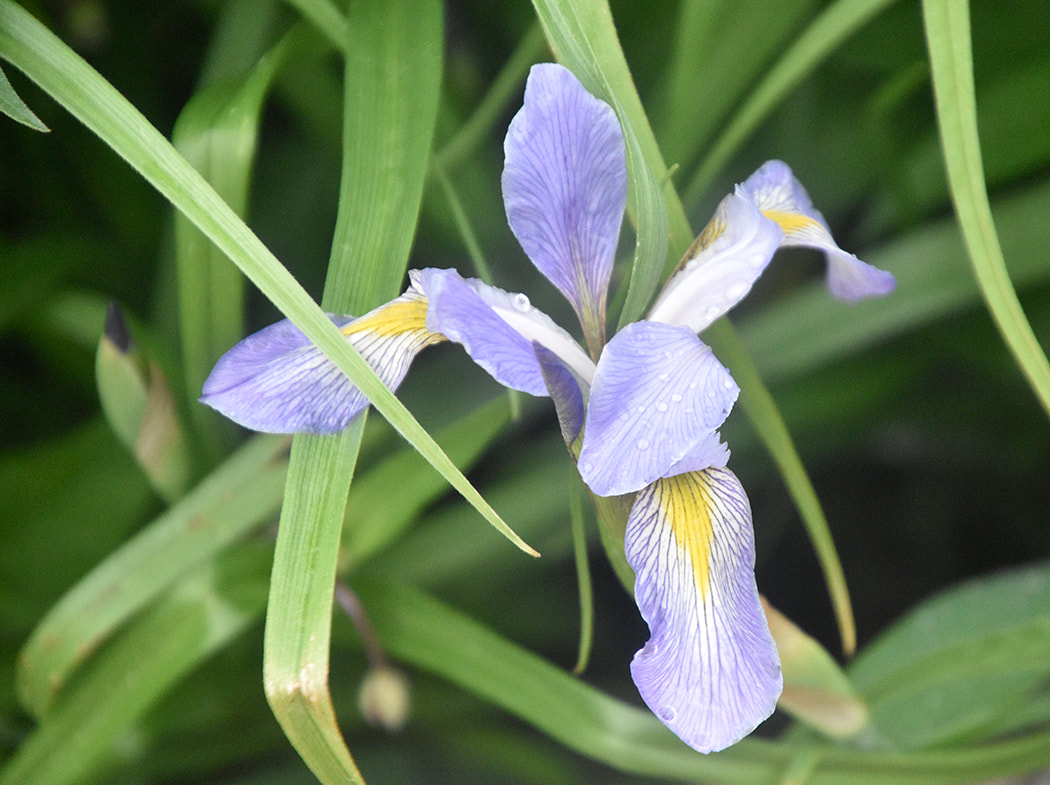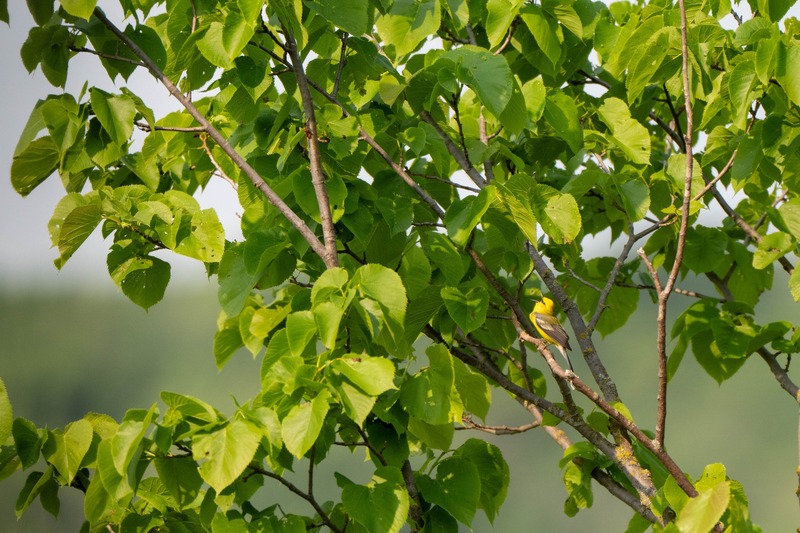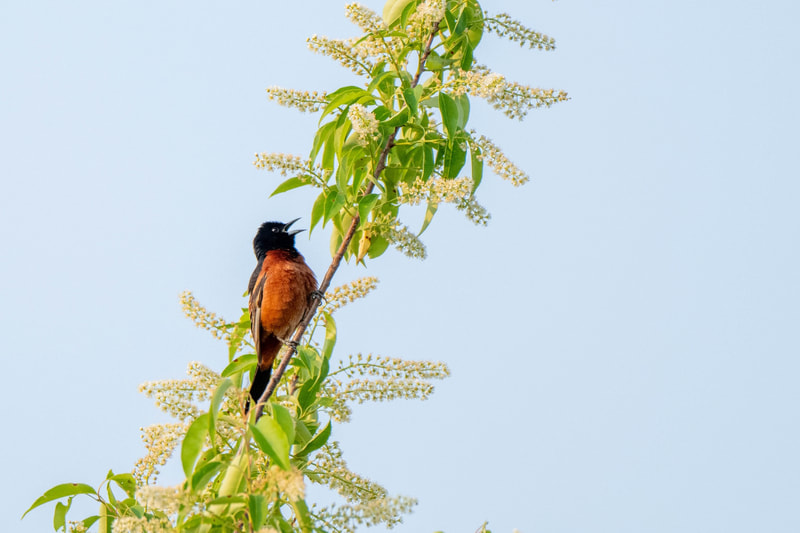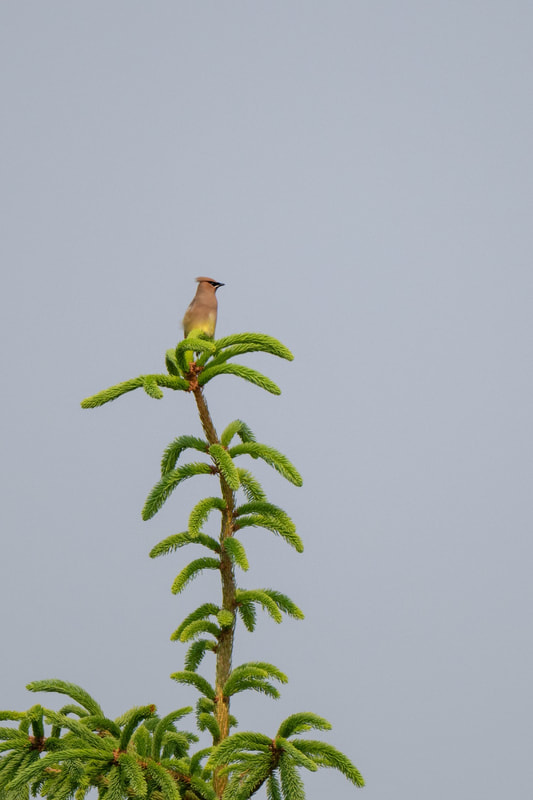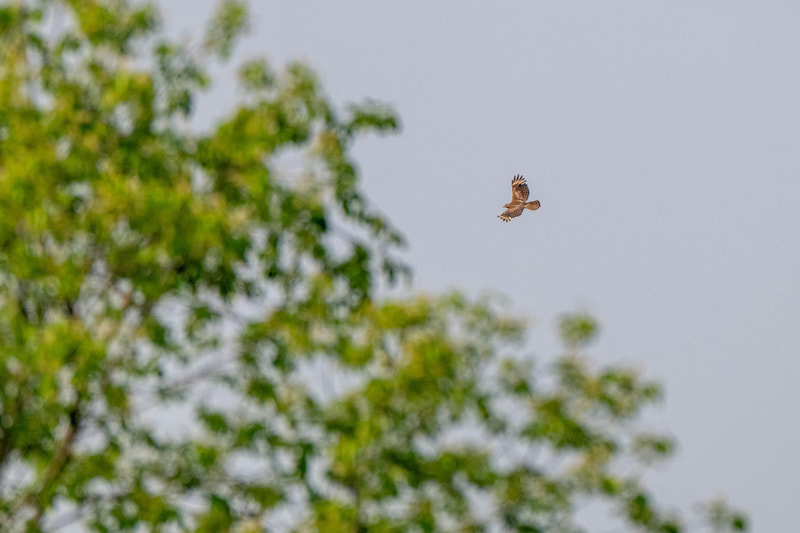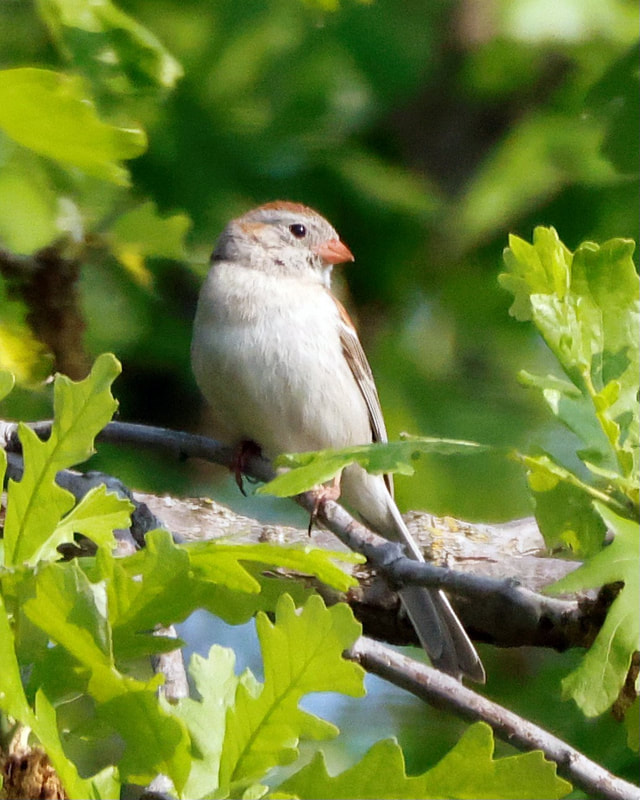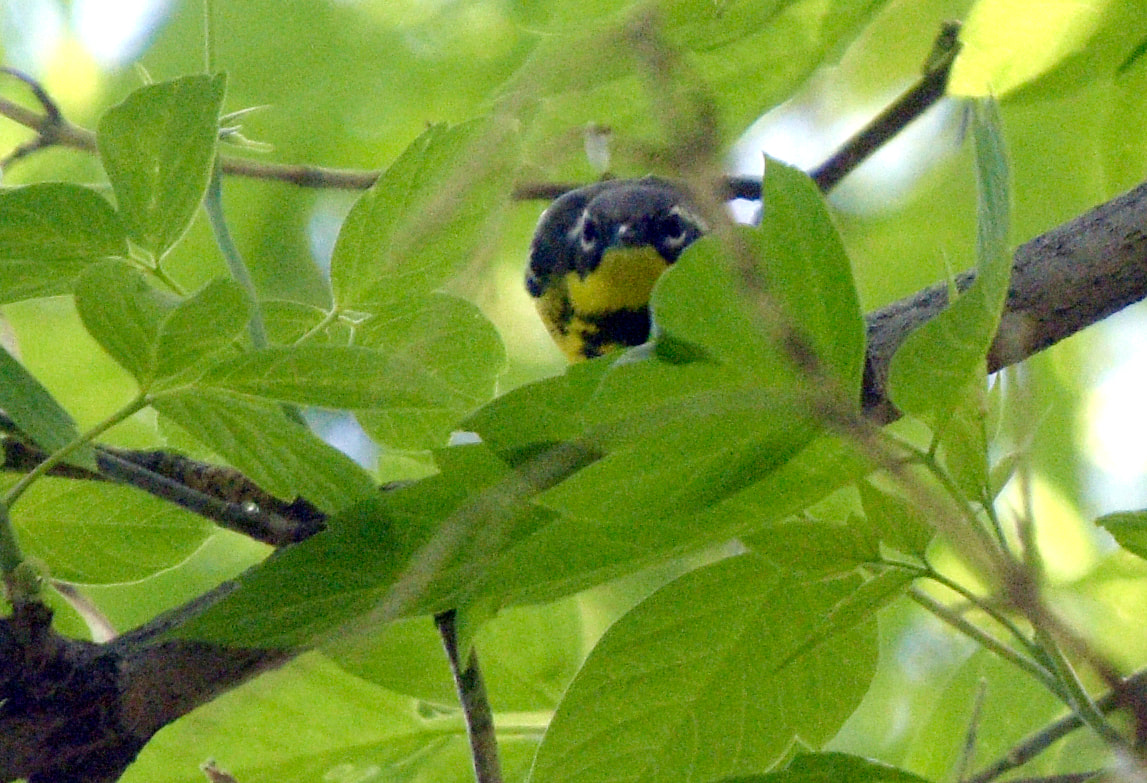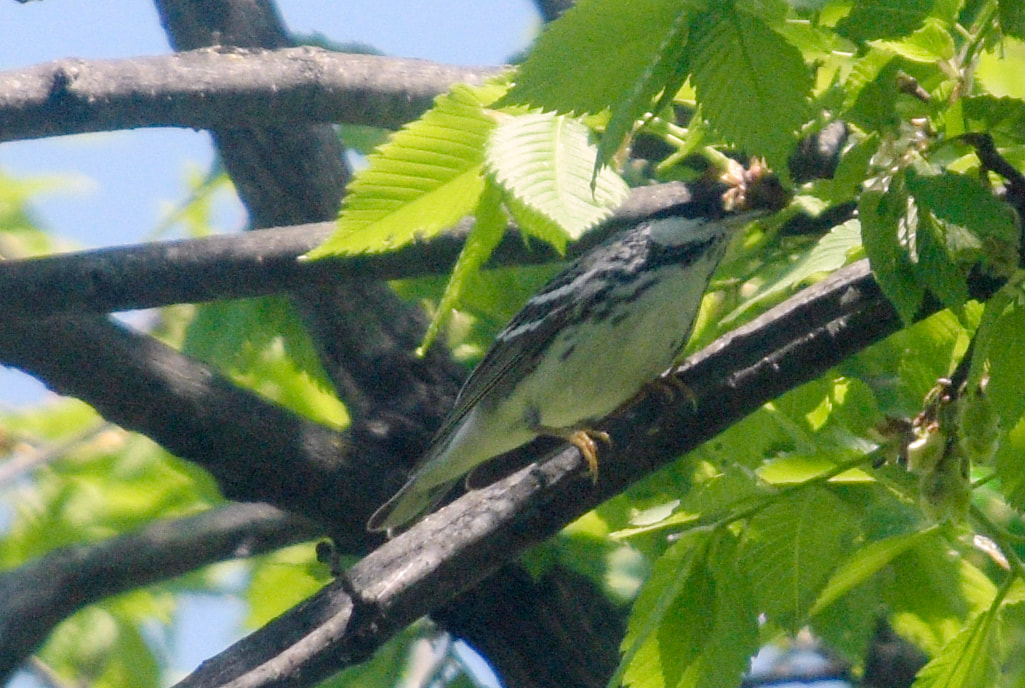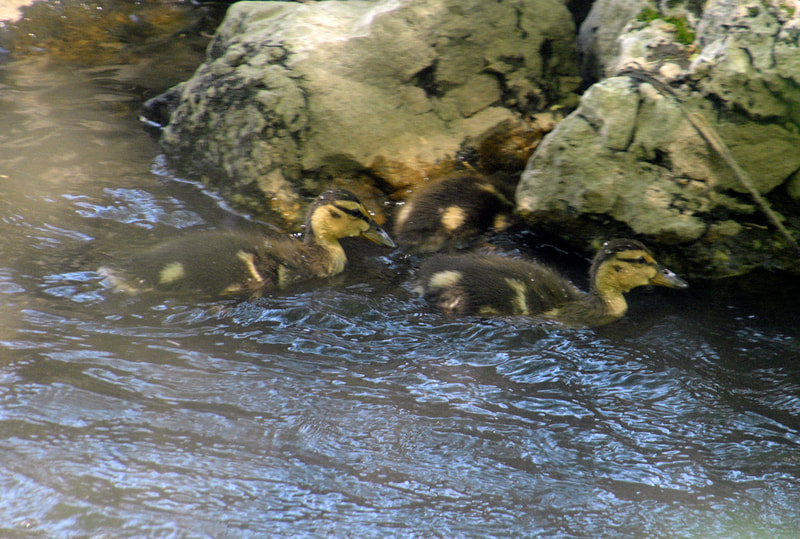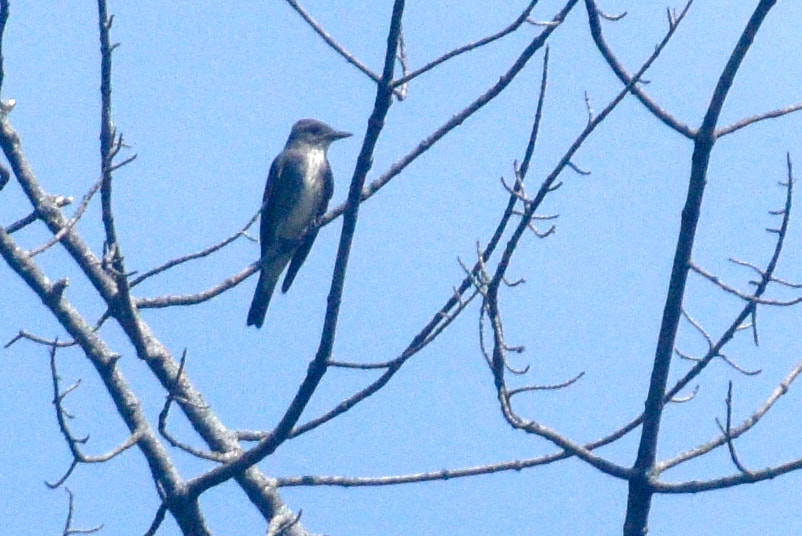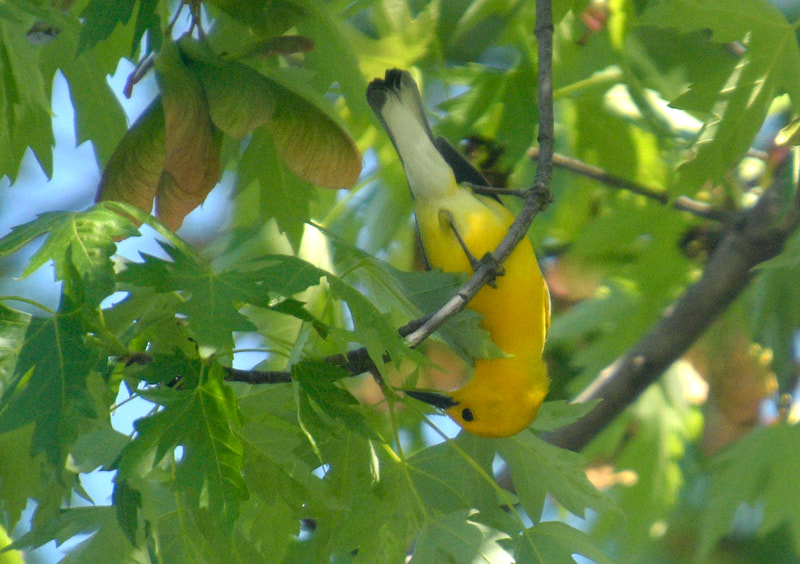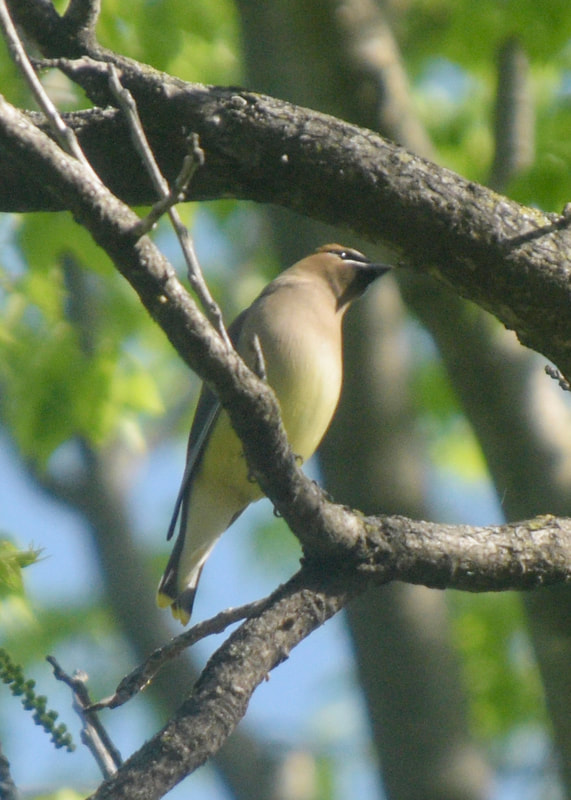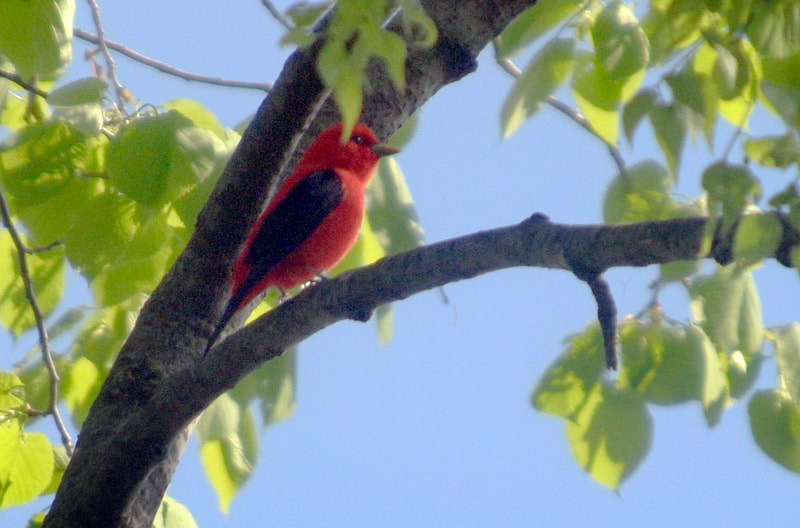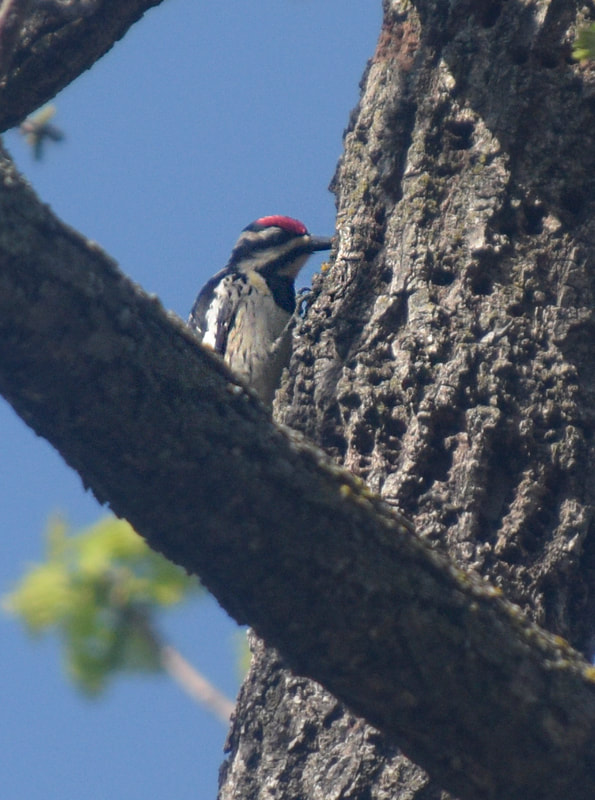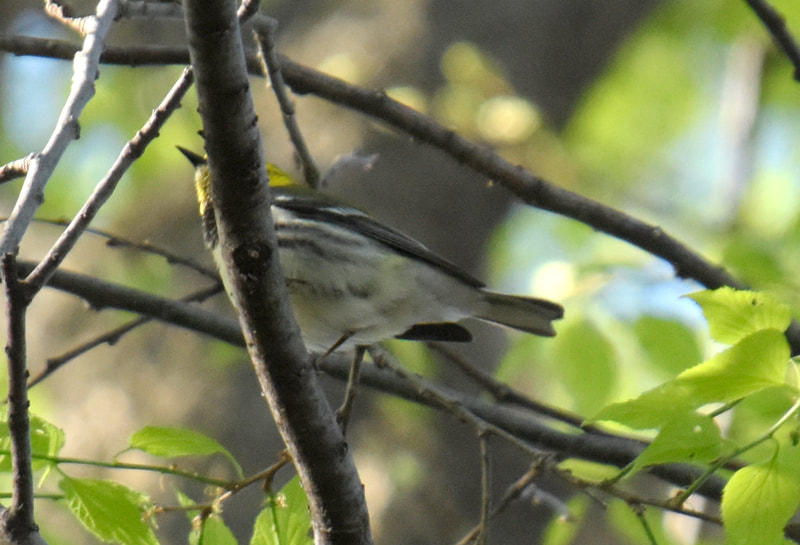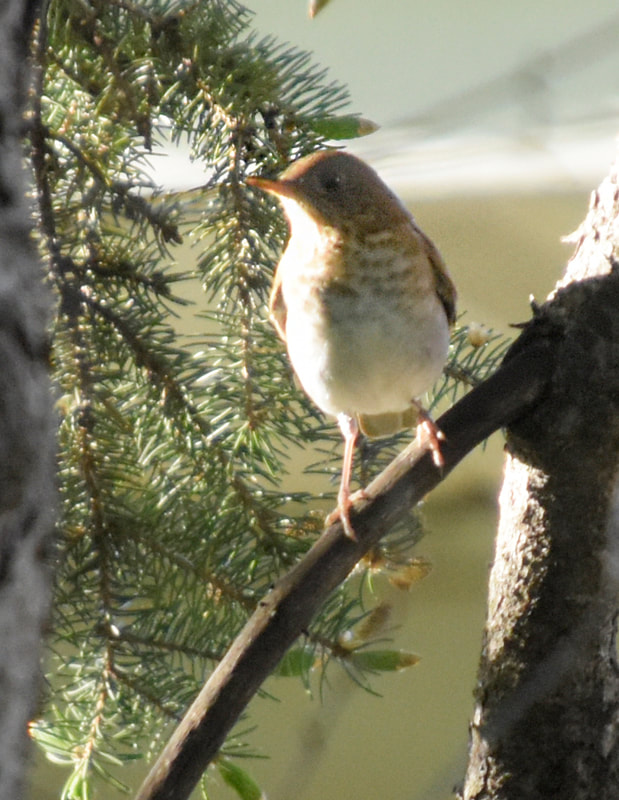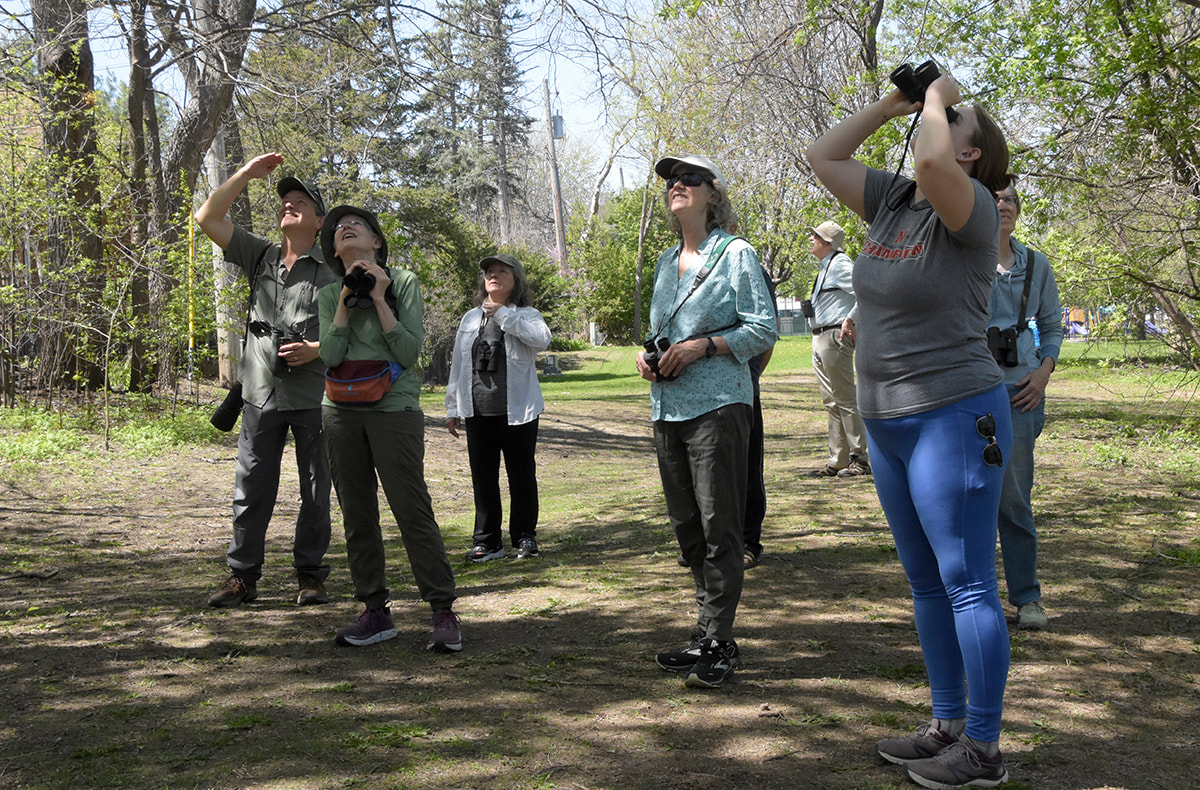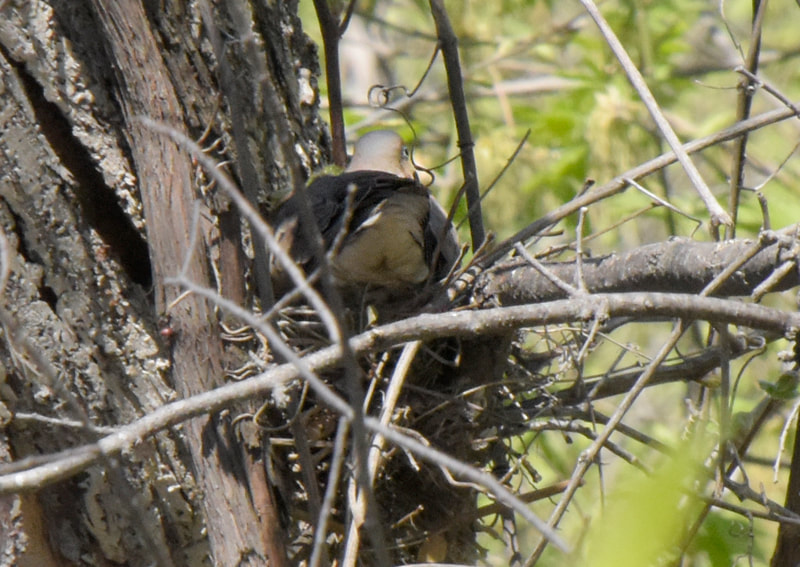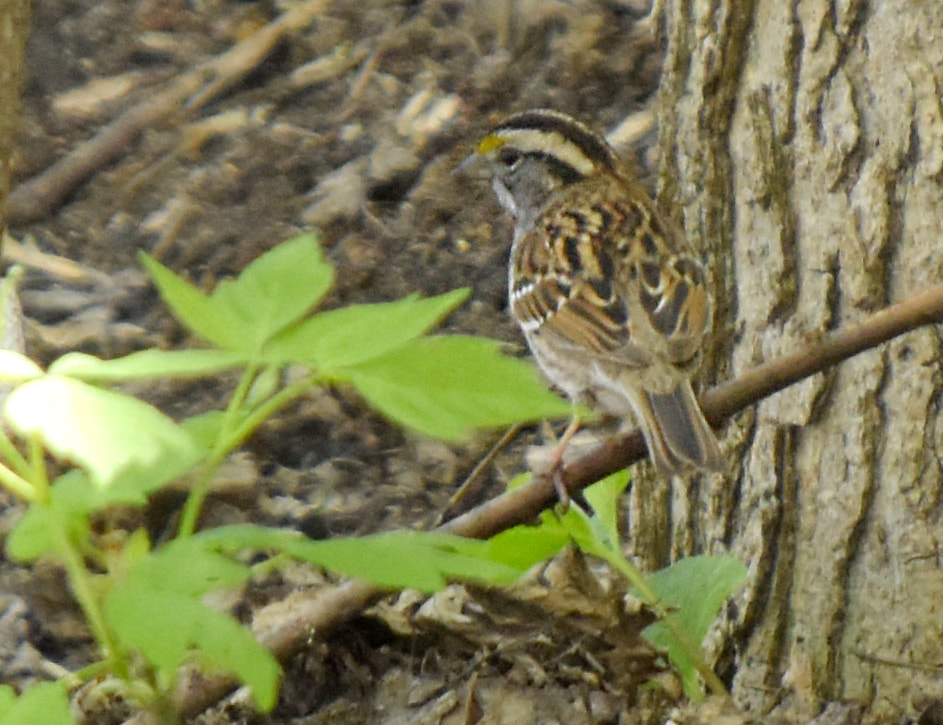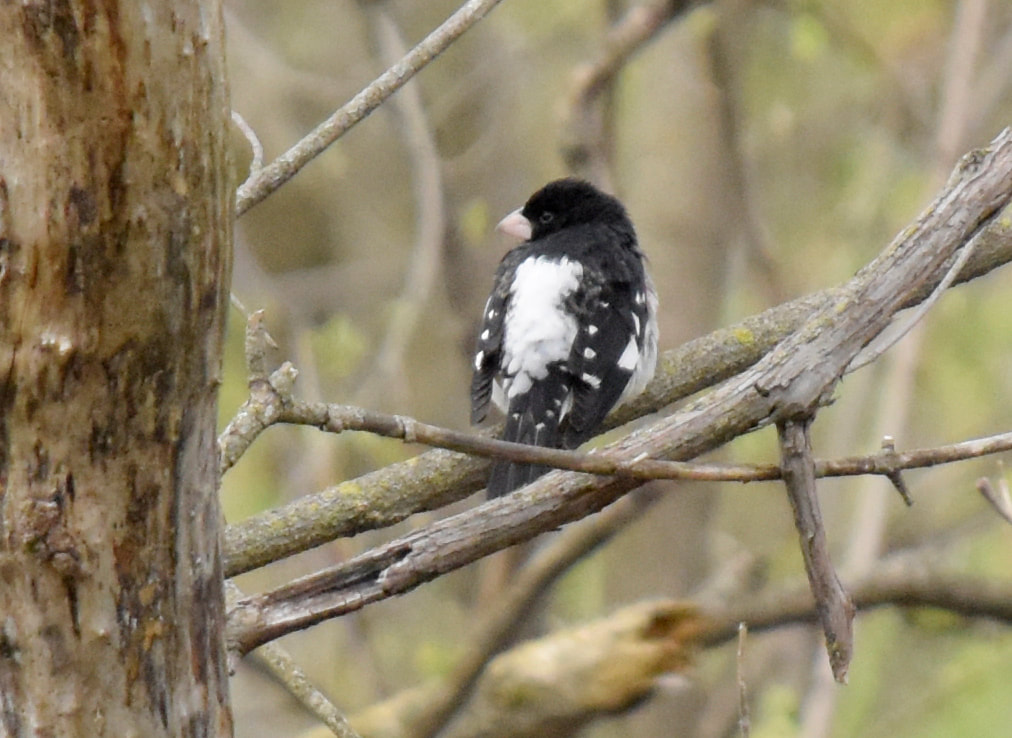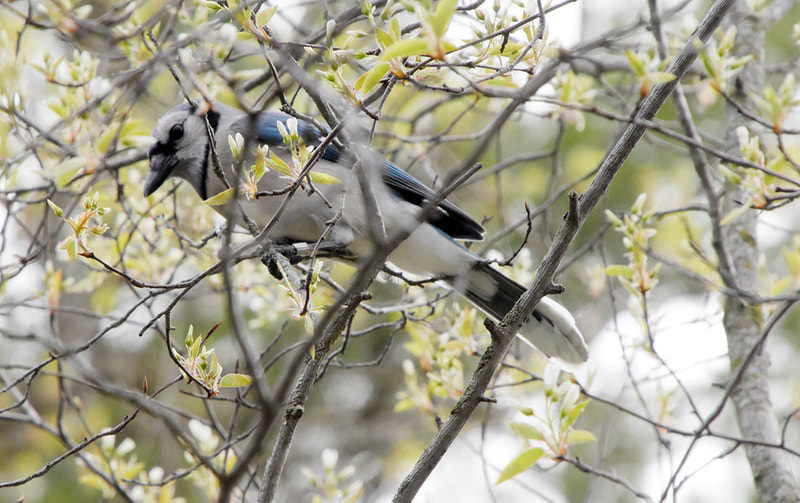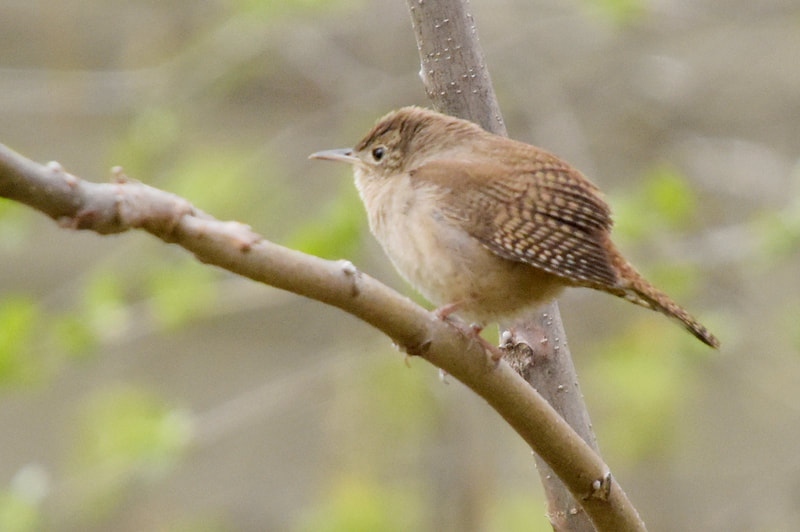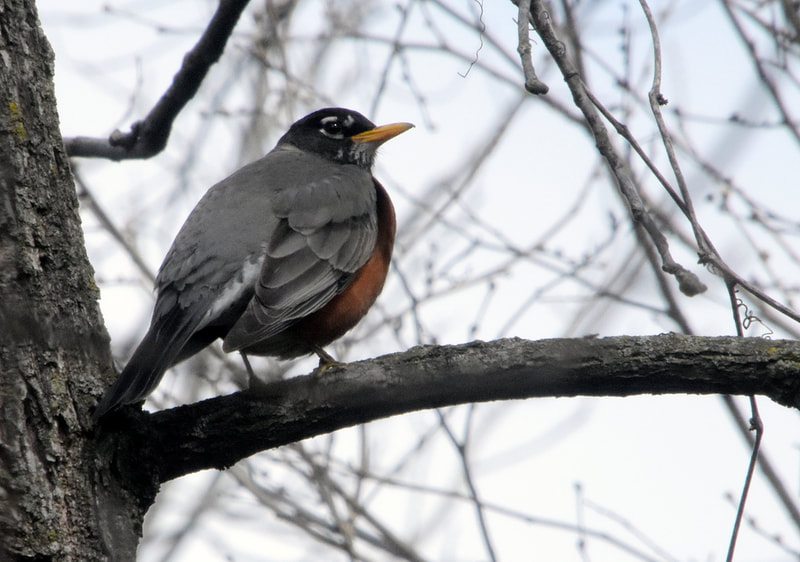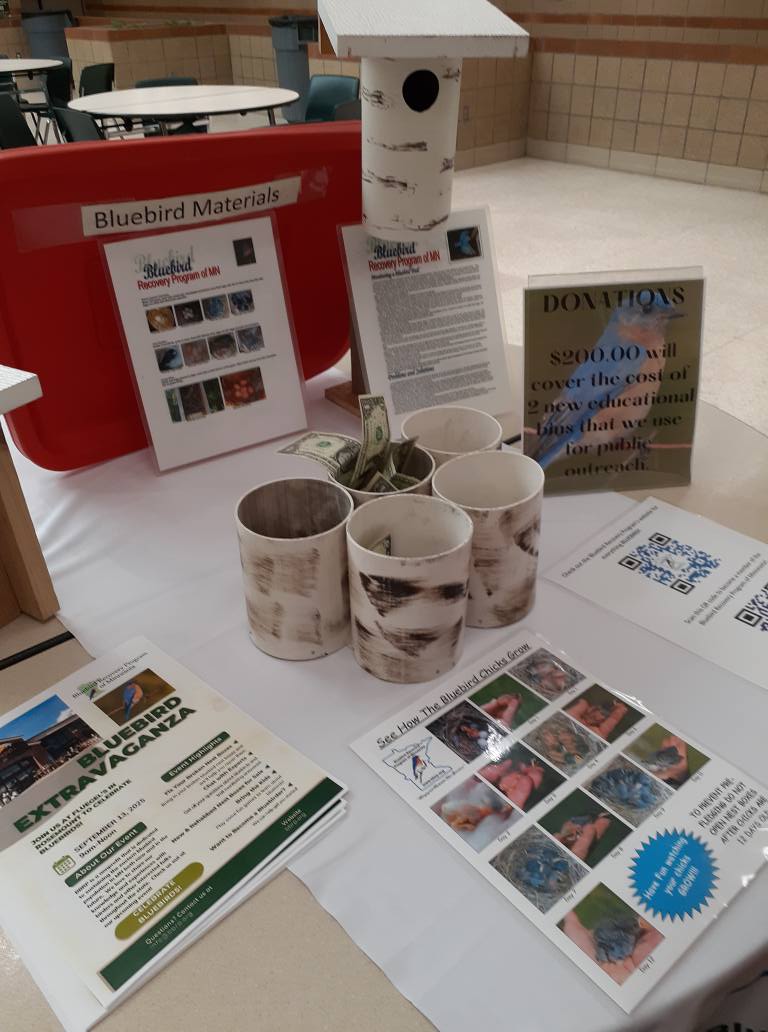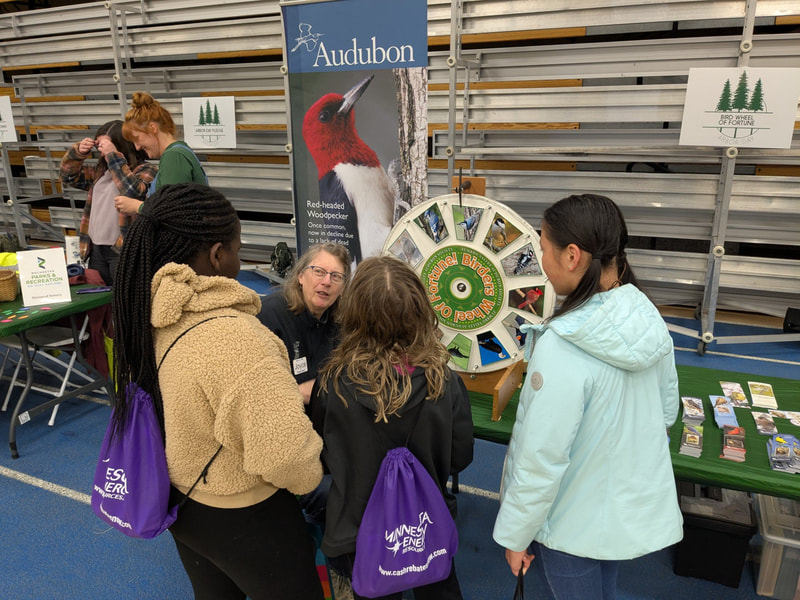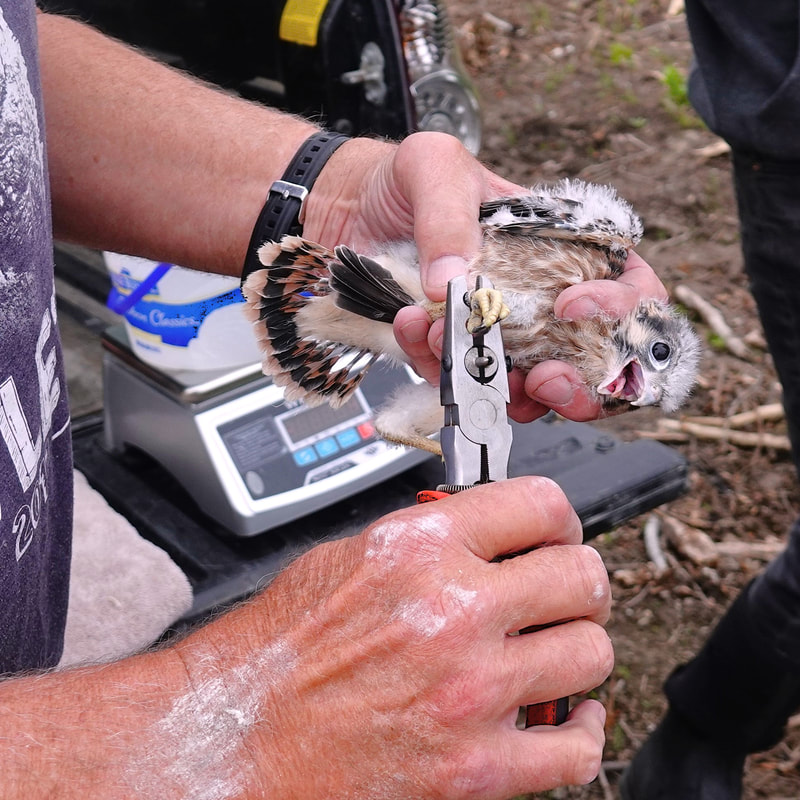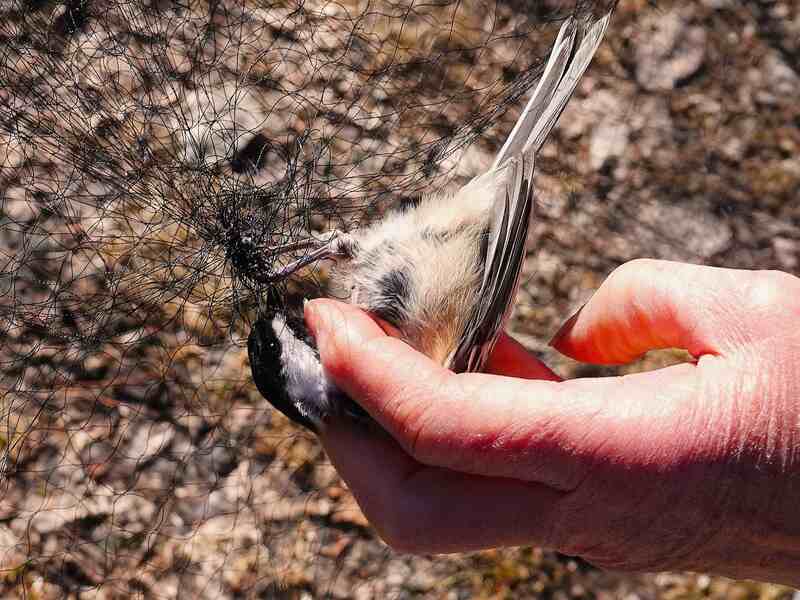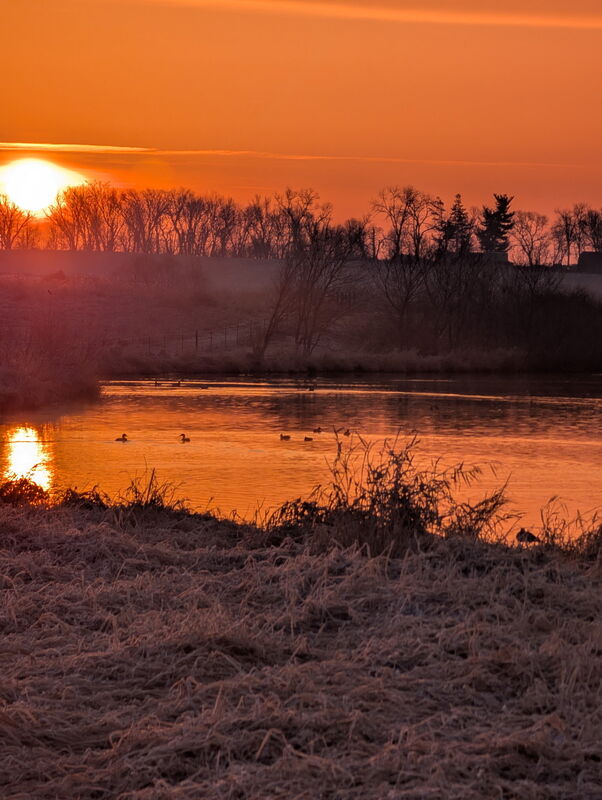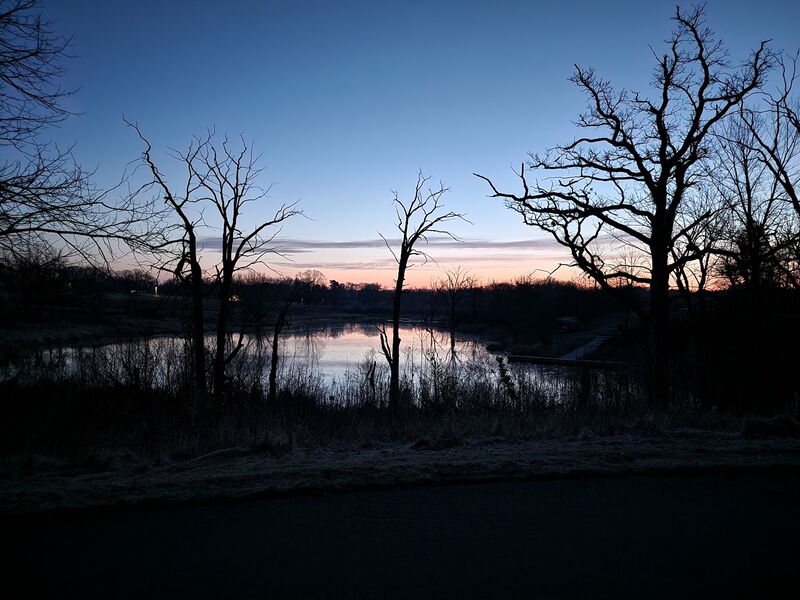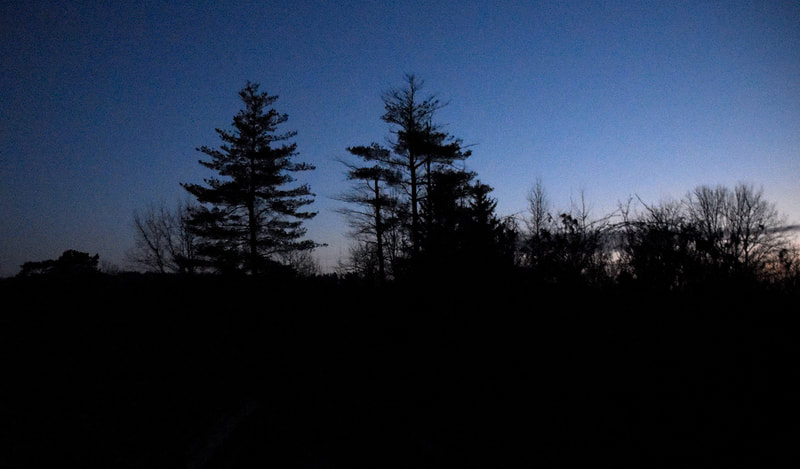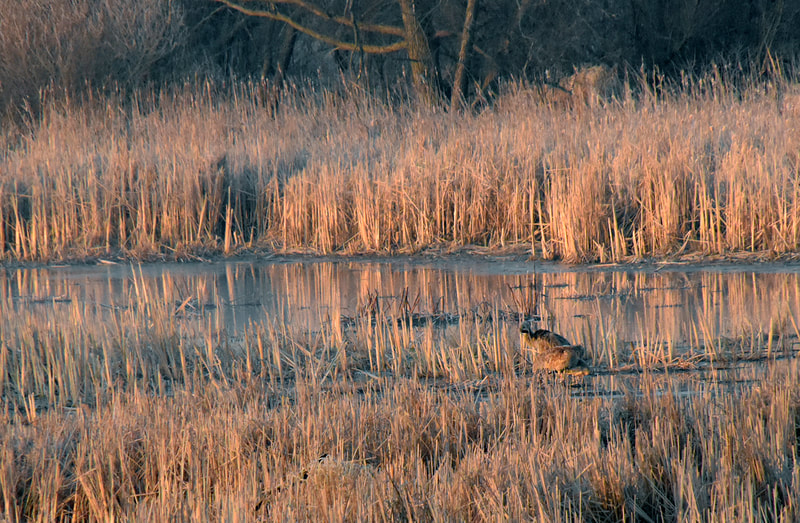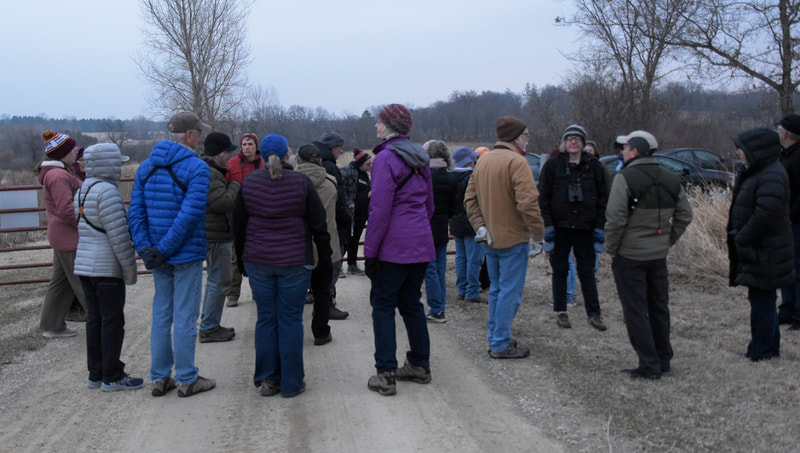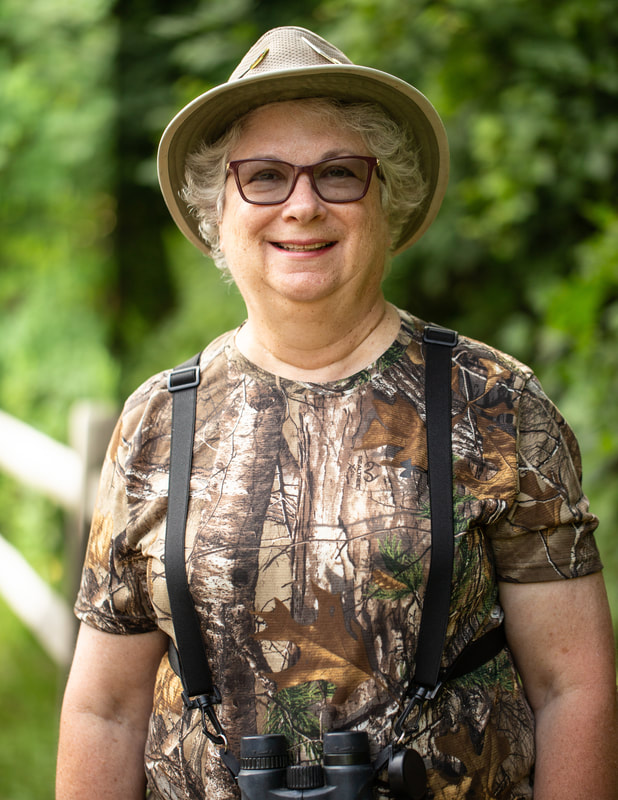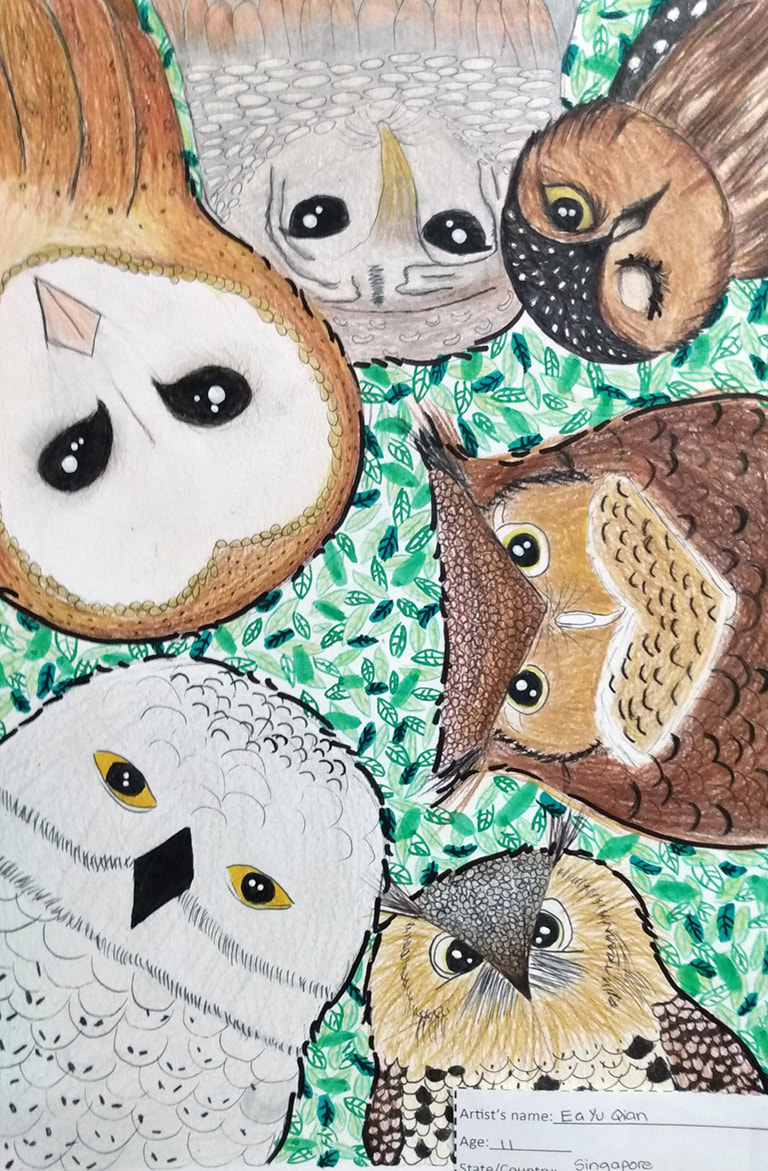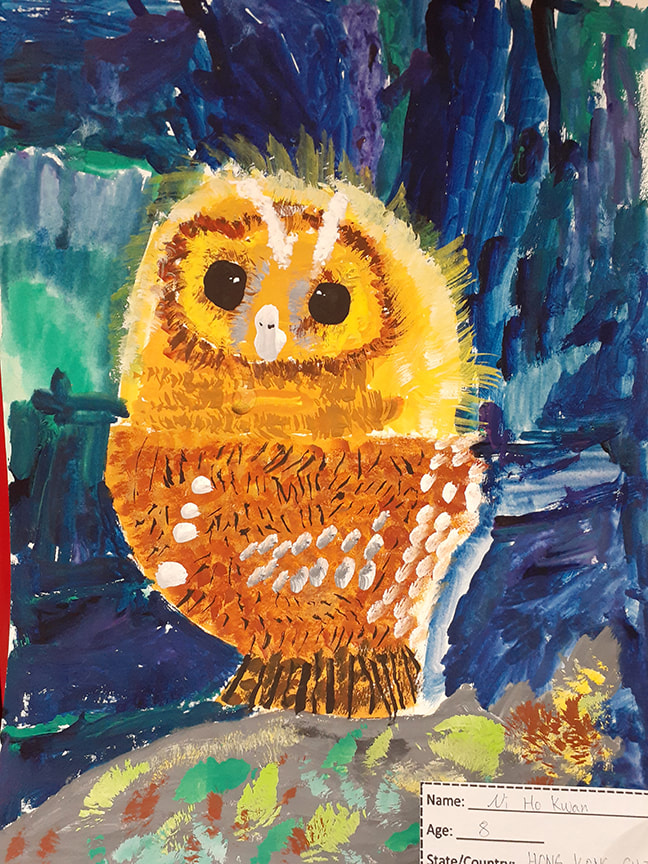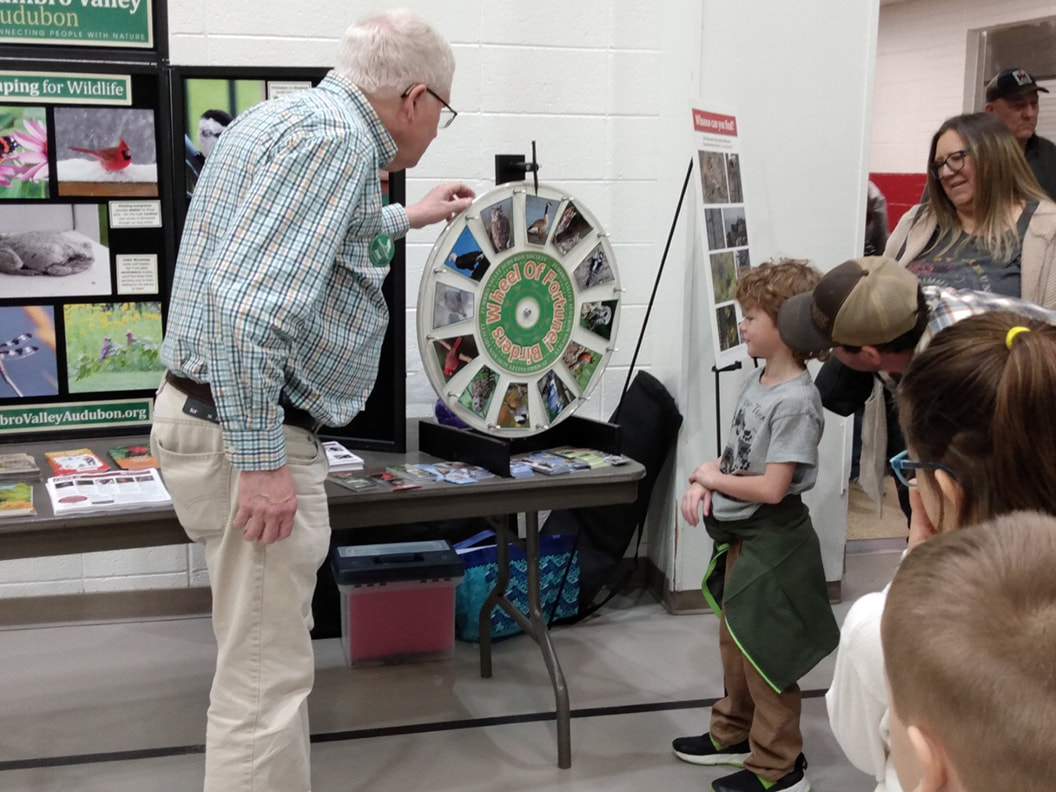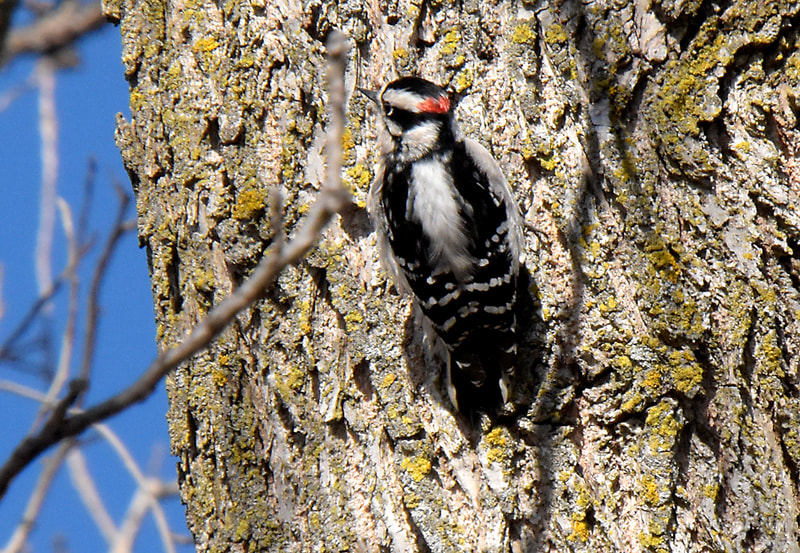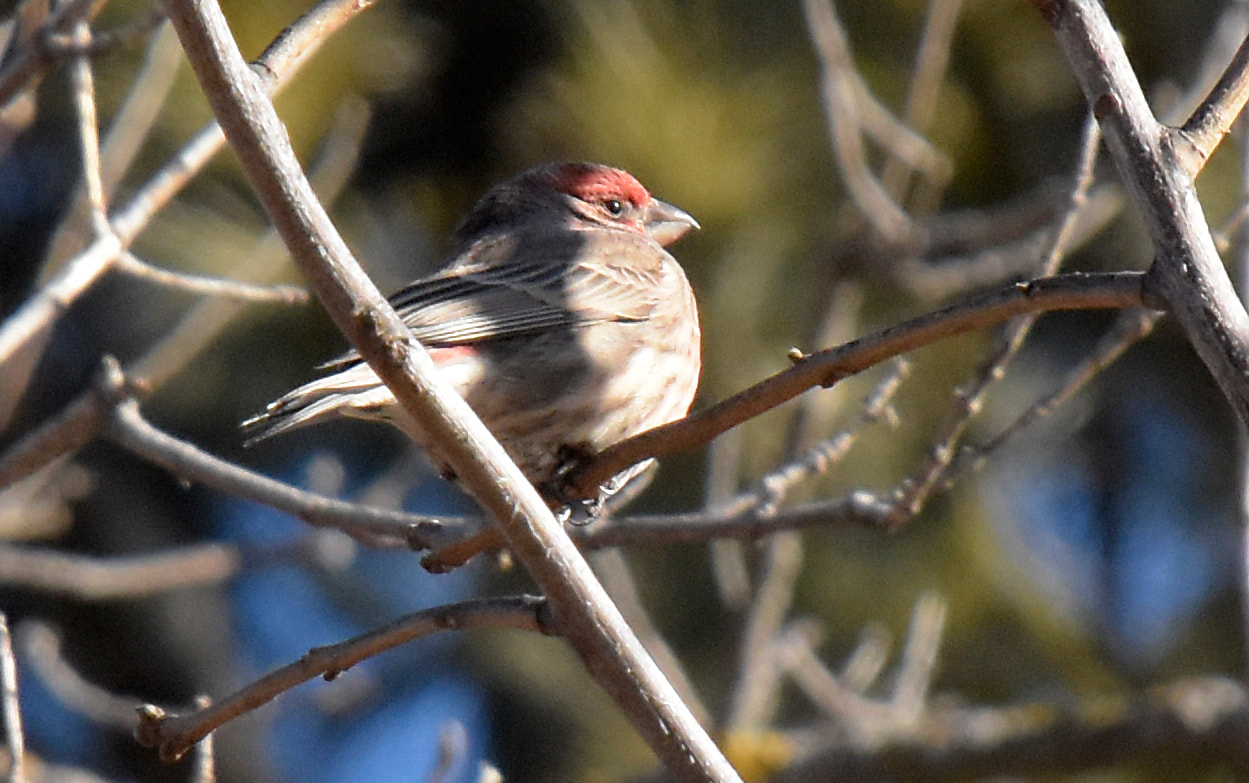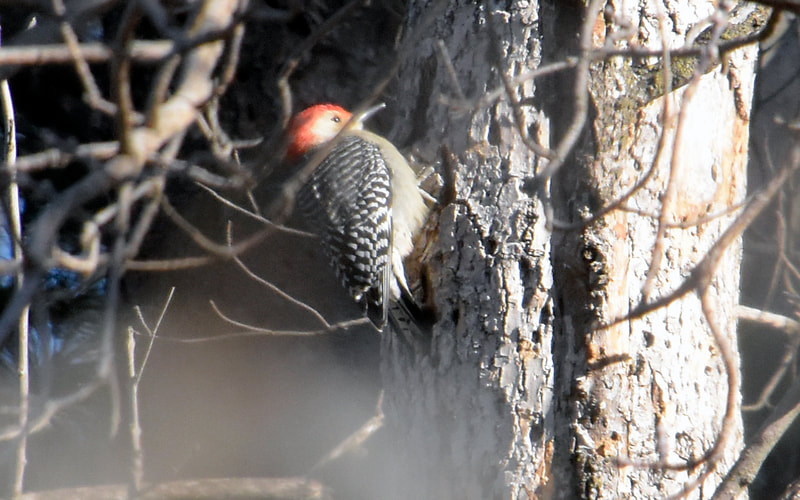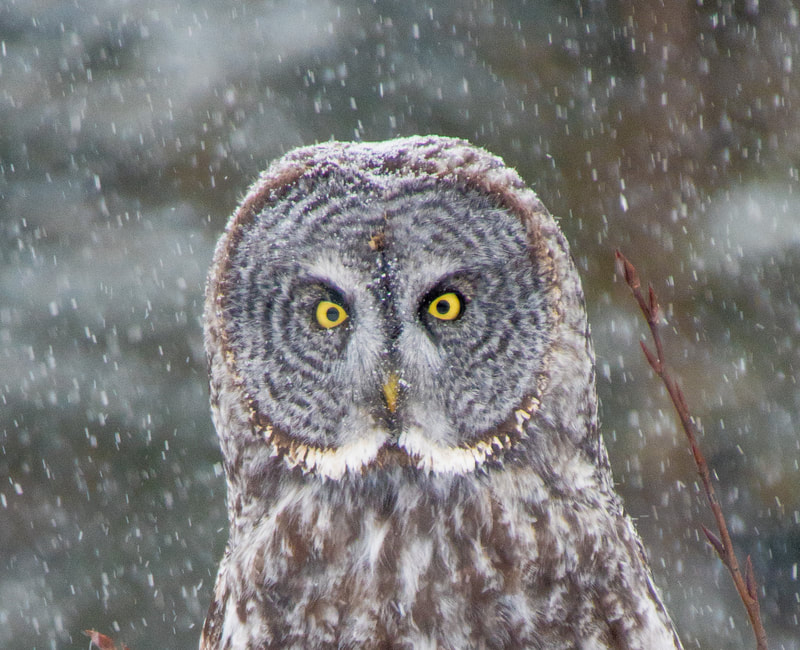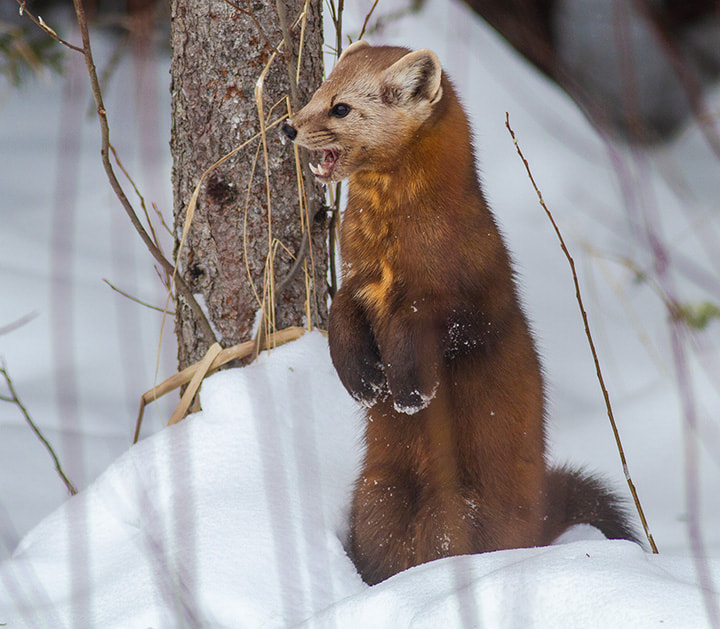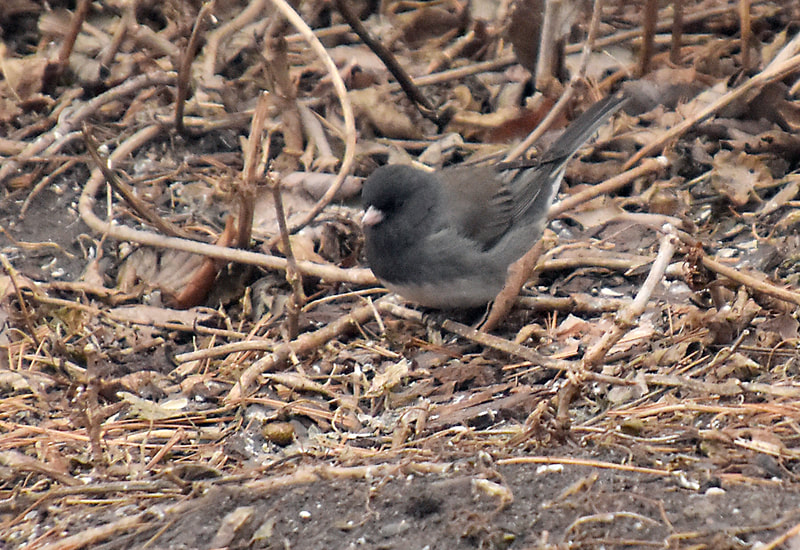NEWSLETTERS ~ CURRENT NEWS ~ BUTTERFLY COUNT ~ CHRISTMAS BIRD COUNT ~ NATIVE PLANTS & PRAIRIE ~ VOLUNTEER
Current News
July 10, 2025 - Potluck & Social at Oxbow Park
A damp, gray day eventually turned into a wonderfully sunny evening as 14 people met up at Oxbow Park near Byron for our annual ZVAS Potluck and Social. While setting up the food table we were entertained by a pair of Barn Swallows bringing food to their nestlings under the shelter - we tried not to bother them too much. Then we all tucked in to a large assortment of tasty food, treats and conversation. Later most of the group took a short walk through the wood in a vain attempt to burn off some of the calories consumed - sure I'll have another cupcake!
During our meal and on the walk we spotted 27 species of birds including:
Ruby-throated Hummingbird, Sandhill Crane, Killdeer, Red-tailed Hawk, Yellow-bellied Sapsucker, Downy Woodpecker, Eastern Wood-Pewee, Eastern Phoebe, Great Crested Flycatcher, Warbling Vireo, Red-eyed Vireo, Barn Swallow, White-breasted Nuthatch, Blue-gray Gnatcatcher, Northern House Wren, Gray Catbird, American Robin, House Sparrow, American Goldfinch, Chipping Sparrow, Song Sparrow, Red-winged Blackbird, Common Yellowthroat, American Redstart, Yellow Warbler, Northern Cardinal, Indigo Bunting
Thanks to everyone who came out! We enjoyed getting to know you better.
A damp, gray day eventually turned into a wonderfully sunny evening as 14 people met up at Oxbow Park near Byron for our annual ZVAS Potluck and Social. While setting up the food table we were entertained by a pair of Barn Swallows bringing food to their nestlings under the shelter - we tried not to bother them too much. Then we all tucked in to a large assortment of tasty food, treats and conversation. Later most of the group took a short walk through the wood in a vain attempt to burn off some of the calories consumed - sure I'll have another cupcake!
During our meal and on the walk we spotted 27 species of birds including:
Ruby-throated Hummingbird, Sandhill Crane, Killdeer, Red-tailed Hawk, Yellow-bellied Sapsucker, Downy Woodpecker, Eastern Wood-Pewee, Eastern Phoebe, Great Crested Flycatcher, Warbling Vireo, Red-eyed Vireo, Barn Swallow, White-breasted Nuthatch, Blue-gray Gnatcatcher, Northern House Wren, Gray Catbird, American Robin, House Sparrow, American Goldfinch, Chipping Sparrow, Song Sparrow, Red-winged Blackbird, Common Yellowthroat, American Redstart, Yellow Warbler, Northern Cardinal, Indigo Bunting
Thanks to everyone who came out! We enjoyed getting to know you better.
July5, 2025 - Bird Walk at Quarry Hill
It was a soggy morning for a bird walk at Quarry Hill this morning so our group of 6 stayed in the Bird Room where it was nice an dry. We later found out that 2 people braved the rain and took a short walk around the pond where they found a Kingfisher, an Indigo Bunting and lots of mosquitoes.
From the Bird Room we spotted several Northern Cardinals, Rose-breasted Grosbeaks, Downy Woodpeckers, a White-breasted Nuthatch, House Finches, Goldfinches, a Robin, a Black-capped Chickadee and a couple House Sparrows. Most of the birds were looking wet and bedraggled and just wanted something to eat.
A little after 10 am the rain lightened up so we went outside and quickly found Cedar Waxwings, Brown-headed Cowbirds, a Barn Swallow and heard a Northern House Wren singing. So just 15 species in all - but we know there were many more out there - we were just too lazy to go find them this morning. Maybe we did too much celebrating on the 4th last night!
Thanks to Terry, Joyce and Dave for spotting birds. Photos by Sandy Hokanson.
It was a soggy morning for a bird walk at Quarry Hill this morning so our group of 6 stayed in the Bird Room where it was nice an dry. We later found out that 2 people braved the rain and took a short walk around the pond where they found a Kingfisher, an Indigo Bunting and lots of mosquitoes.
From the Bird Room we spotted several Northern Cardinals, Rose-breasted Grosbeaks, Downy Woodpeckers, a White-breasted Nuthatch, House Finches, Goldfinches, a Robin, a Black-capped Chickadee and a couple House Sparrows. Most of the birds were looking wet and bedraggled and just wanted something to eat.
A little after 10 am the rain lightened up so we went outside and quickly found Cedar Waxwings, Brown-headed Cowbirds, a Barn Swallow and heard a Northern House Wren singing. So just 15 species in all - but we know there were many more out there - we were just too lazy to go find them this morning. Maybe we did too much celebrating on the 4th last night!
Thanks to Terry, Joyce and Dave for spotting birds. Photos by Sandy Hokanson.
June 15, 2025 - Damsels & Dragonflies at Chester Woods
After a cloudy, cool morning we were happy to have enough warmth and sunshine by early afternoon to get the dragonflies up and flying around (if it's cooler than 70 they tend not to fly). About 15 people came out to catch, hold and get closeup looks at our Damsels & Dragonflies event.
Joel's support team came early and netted several nymphs that we could watch swimming in a small aquarium - they look ferocious up close! One young participant even found an "exuvia", the discarded exoskeleton of a nymph from which an adult dragonfly emerges.
We found several species including Bluets, Eastern Forktails, Dot-Tailed Whiteface, Common Baskettails, 12-spotted Skimmers and more. As the summer progresses even more varieties of these beneficial insects will hatch and help us control the mosquito and gnat populations.
Many thanks to Joel Dunnette for leading this event and to volunteers Gary, Jay, Kirk & Ezra. Photos by Sandy Hokanson.
After a cloudy, cool morning we were happy to have enough warmth and sunshine by early afternoon to get the dragonflies up and flying around (if it's cooler than 70 they tend not to fly). About 15 people came out to catch, hold and get closeup looks at our Damsels & Dragonflies event.
Joel's support team came early and netted several nymphs that we could watch swimming in a small aquarium - they look ferocious up close! One young participant even found an "exuvia", the discarded exoskeleton of a nymph from which an adult dragonfly emerges.
We found several species including Bluets, Eastern Forktails, Dot-Tailed Whiteface, Common Baskettails, 12-spotted Skimmers and more. As the summer progresses even more varieties of these beneficial insects will hatch and help us control the mosquito and gnat populations.
Many thanks to Joel Dunnette for leading this event and to volunteers Gary, Jay, Kirk & Ezra. Photos by Sandy Hokanson.
June 11, 2025 - Visiting a Beef Farm
Our visit to John and Linda Meyer's beef farm yielded an abundance of grassland birds. It was no surprise because these beef cattle are rotationally grazed where the pastures have a lot of recovery time and provide good nesting habitat. We saw/heard many bobolink, dickcissel, savanna and grasshopper sparrows as we walked across the paddocks. Grassland birds have seen a decline of over 50% since the 1970s. We only saw one Eastern meadowlark but there was ample habitat for more so that was concerning. The grasshopper sparrow is classified as a bird in steep decline. Obviously, Meyer's farming practices can help this bird recover. A great find was a Northern harrier which is rarely seen in Olmsted county other than during migration. Seeing one today indicates that this farm is great wildlife habitat. Surprisingly, this farm used to be row-cropped just 8 years ago and it doesn't take very long to provide homes to struggling bird species.
The beef is direct-marketed to consumers so if you want to support excellent bird habitat then email John at: jlmeyer@kmtel.com .
Thanks again to John for a tour of his farm / wildlife habitat. Thanks to Joel Dunnette and Lance Vrieze for helping out and for Mike Degerstrom for leading.
The 43 species of birds seen on the farm and along a neighboring wildlife management area were: Mallard, Ring-necked Pheasant, Eurasian Collared-Dove, Mourning Dove, Killdeer, Northern Harrier, Hairy Woodpecker, Northern Flicker, Great Crested Flycatcher, Eastern Kingbird, Willow Flycatcher, Warbling Vireo, Blue Jay, American Crow, Black-capped Chickadee, Bank Swallow, Tree Swallow, Barn Swallow, Cliff Swallow, Northern House Wren, European Starling, Gray Catbird, Brown Thrasher, American Robin, Cedar Waxwing, House Sparrow, American Goldfinch, Grasshopper Sparrow, Chipping Sparrow, Vesper Sparrow, Savannah Sparrow, Song Sparrow, Swamp Sparrow, Bobolink, Eastern Meadowlark, Red-winged Blackbird, Brown-headed Cowbird, Common Grackle, Common Yellowthroat, Yellow Warbler, Northern Cardinal, Rose-breasted Grosebeak, Dickcissel.
Our visit to John and Linda Meyer's beef farm yielded an abundance of grassland birds. It was no surprise because these beef cattle are rotationally grazed where the pastures have a lot of recovery time and provide good nesting habitat. We saw/heard many bobolink, dickcissel, savanna and grasshopper sparrows as we walked across the paddocks. Grassland birds have seen a decline of over 50% since the 1970s. We only saw one Eastern meadowlark but there was ample habitat for more so that was concerning. The grasshopper sparrow is classified as a bird in steep decline. Obviously, Meyer's farming practices can help this bird recover. A great find was a Northern harrier which is rarely seen in Olmsted county other than during migration. Seeing one today indicates that this farm is great wildlife habitat. Surprisingly, this farm used to be row-cropped just 8 years ago and it doesn't take very long to provide homes to struggling bird species.
The beef is direct-marketed to consumers so if you want to support excellent bird habitat then email John at: jlmeyer@kmtel.com .
Thanks again to John for a tour of his farm / wildlife habitat. Thanks to Joel Dunnette and Lance Vrieze for helping out and for Mike Degerstrom for leading.
The 43 species of birds seen on the farm and along a neighboring wildlife management area were: Mallard, Ring-necked Pheasant, Eurasian Collared-Dove, Mourning Dove, Killdeer, Northern Harrier, Hairy Woodpecker, Northern Flicker, Great Crested Flycatcher, Eastern Kingbird, Willow Flycatcher, Warbling Vireo, Blue Jay, American Crow, Black-capped Chickadee, Bank Swallow, Tree Swallow, Barn Swallow, Cliff Swallow, Northern House Wren, European Starling, Gray Catbird, Brown Thrasher, American Robin, Cedar Waxwing, House Sparrow, American Goldfinch, Grasshopper Sparrow, Chipping Sparrow, Vesper Sparrow, Savannah Sparrow, Song Sparrow, Swamp Sparrow, Bobolink, Eastern Meadowlark, Red-winged Blackbird, Brown-headed Cowbird, Common Grackle, Common Yellowthroat, Yellow Warbler, Northern Cardinal, Rose-breasted Grosebeak, Dickcissel.
June 10, 2025 - Birding by ear for folks with limited vision
This afternoon we visited a group after their Braille class to listen for and talk about birds. Thanks for Edward for pulling this together, for Jan to offer the site, and Mike (from ZVAS) to lead the ear-birding. It was a slow afternoon but that gave us time to answer the many insightful questions. Birds heard are: Mourning dove, Red-bellied woodpecker, Downy woodpecker, Blue jay, American crow, Black-capped chickadee, Chimney swift, American robin, House finch, and Northern cardinal.
It is very difficult to hear birds really well because they generally are not that close to you and there is so much human-caused noise.
Here are a few clips recorded over the past few years where the birds were extremely cooperative in providing good audio.
https://macaulaylibrary.org/asset/637389846
https://macaulaylibrary.org/asset/335659661
https://macaulaylibrary.org/asset/335154771
This afternoon we visited a group after their Braille class to listen for and talk about birds. Thanks for Edward for pulling this together, for Jan to offer the site, and Mike (from ZVAS) to lead the ear-birding. It was a slow afternoon but that gave us time to answer the many insightful questions. Birds heard are: Mourning dove, Red-bellied woodpecker, Downy woodpecker, Blue jay, American crow, Black-capped chickadee, Chimney swift, American robin, House finch, and Northern cardinal.
It is very difficult to hear birds really well because they generally are not that close to you and there is so much human-caused noise.
Here are a few clips recorded over the past few years where the birds were extremely cooperative in providing good audio.
https://macaulaylibrary.org/asset/637389846
https://macaulaylibrary.org/asset/335659661
https://macaulaylibrary.org/asset/335154771
June 8, 2025 - Field Trip to Grand Meadow Chert Quarry & Lake Louise State Park
What a fun day! Thirty-one of us met Tom Trow at the Grand Meadow Chert Quarry south of Rochester this morning for a guided tour of this important historical site. Tom had had described the history of the site at our May program and we were intrigued. In person the site is incredible. Well-groomed trails wind through the wooded part of the quarry. Informational signs scattered throughout tell the story of how native tribes mined chert to make tools, and stone benches are placed to rest and think and imagine what happened here. This site opens to the public in July and it's well worth a visit. Find out more here: https://mowercountyhistory.org/locations/the-grand-meadow-chert-quarry/
We stayed at the Chert Quarry for nearly 2 hours. Tom pointed out some huge old bur oaks believed to be nearly 500 years old, showed us samples of the chert and described future plans for further excavations.
After the tour about half of our group continued on to nearby Lake Louise State Park where we had a picnic lunch followed by a bird walk. Many thanks to Kate (a park advocate) for guiding us on her "favorite bird trail". Lake Louise SP is another under-appreciated park with lots of great and varied habitat. We saw at least 33 species of birds there with a Common Nighthawk roosting in an oak near our picnic table being a favorite. We found Red-headed Woodpeckers in both locations. At Lake Louise we also spotted several species of butterflies and noticed Golden Oyster mushrooms on several trees.
We hope to return to this area next spring. Many thanks to our trip organizers Joan Leof and Sue Hayes, to Tom Trow for our guided tour, and to our photographers, Sandy Hokanson, Brendan Lanpher & Dave Gross.
Grand Meadow Chert Quarry Birds (at least 21 species - I may have missed a few)
Wood Duck, Ring-necked Pheasant, Mourning Dove, Turkey Vulture, Red-headed Woodpecker, Red-bellied Woodpecker, Hairy Woodpecker, Great Crested Flycatcher, Blue Jay, Tree Swallow, Cliff Swallow, White-breasted Nuthatch, Northern House Wren, Gray Catbird, American Robin, Vesper Sparrow, Song Sparrow, Baltimore Oriole, Red-winged Blackbird, Brown-headed Cowbird, Common Yellowthroat
Lake Louise State Park Birds (33 species)
Common Nighthawk, Chimney Swift, Ruby-throated Hummingbird, Turkey Vulture, Red-tailed Hawk, Red-headed Woodpecker, Downy Woodpecker, Northern Flicker, Eastern Wood-Pewee, Willow Flycatcher, Great Crested Flycatcher, Eastern Kingbird, Yellow-throated Vireo, Warbling Vireo, Blue Jay, Tree Swallow, Blue-gray Gnatcatcher, Northern House Wren, Eastern Bluebird, American Robin, Cedar Waxwing, American Goldfinch, Chipping Sparrow, Field Sparrow, Song Sparrow, Baltimore Oriole, Red-winged Blackbird, Brown-headed Cowbird, Common Yellowthroat, American Redstart, Yellow Warbler, Rose-breasted Grosbeak, Indigo Bunting
What a fun day! Thirty-one of us met Tom Trow at the Grand Meadow Chert Quarry south of Rochester this morning for a guided tour of this important historical site. Tom had had described the history of the site at our May program and we were intrigued. In person the site is incredible. Well-groomed trails wind through the wooded part of the quarry. Informational signs scattered throughout tell the story of how native tribes mined chert to make tools, and stone benches are placed to rest and think and imagine what happened here. This site opens to the public in July and it's well worth a visit. Find out more here: https://mowercountyhistory.org/locations/the-grand-meadow-chert-quarry/
We stayed at the Chert Quarry for nearly 2 hours. Tom pointed out some huge old bur oaks believed to be nearly 500 years old, showed us samples of the chert and described future plans for further excavations.
After the tour about half of our group continued on to nearby Lake Louise State Park where we had a picnic lunch followed by a bird walk. Many thanks to Kate (a park advocate) for guiding us on her "favorite bird trail". Lake Louise SP is another under-appreciated park with lots of great and varied habitat. We saw at least 33 species of birds there with a Common Nighthawk roosting in an oak near our picnic table being a favorite. We found Red-headed Woodpeckers in both locations. At Lake Louise we also spotted several species of butterflies and noticed Golden Oyster mushrooms on several trees.
We hope to return to this area next spring. Many thanks to our trip organizers Joan Leof and Sue Hayes, to Tom Trow for our guided tour, and to our photographers, Sandy Hokanson, Brendan Lanpher & Dave Gross.
Grand Meadow Chert Quarry Birds (at least 21 species - I may have missed a few)
Wood Duck, Ring-necked Pheasant, Mourning Dove, Turkey Vulture, Red-headed Woodpecker, Red-bellied Woodpecker, Hairy Woodpecker, Great Crested Flycatcher, Blue Jay, Tree Swallow, Cliff Swallow, White-breasted Nuthatch, Northern House Wren, Gray Catbird, American Robin, Vesper Sparrow, Song Sparrow, Baltimore Oriole, Red-winged Blackbird, Brown-headed Cowbird, Common Yellowthroat
Lake Louise State Park Birds (33 species)
Common Nighthawk, Chimney Swift, Ruby-throated Hummingbird, Turkey Vulture, Red-tailed Hawk, Red-headed Woodpecker, Downy Woodpecker, Northern Flicker, Eastern Wood-Pewee, Willow Flycatcher, Great Crested Flycatcher, Eastern Kingbird, Yellow-throated Vireo, Warbling Vireo, Blue Jay, Tree Swallow, Blue-gray Gnatcatcher, Northern House Wren, Eastern Bluebird, American Robin, Cedar Waxwing, American Goldfinch, Chipping Sparrow, Field Sparrow, Song Sparrow, Baltimore Oriole, Red-winged Blackbird, Brown-headed Cowbird, Common Yellowthroat, American Redstart, Yellow Warbler, Rose-breasted Grosbeak, Indigo Bunting
June 7, 2025 - Bird Walk at Quarry Hill
A Blue-winged Warbler was the "bird of the day" on our walk at Quarry Hill this morning. It was up high and often hard to see but definitely a welcome sight as several people had never seen one.
Early morning sun gave way to light sprinkles but our group of 16 didn't seem to mind. As we walked we heard more birds than we saw. It's a bit frustrating to hear a bird and know it's very close but never see it due to all the leaf cover - but that's birding and we enjoy the challenge.
Two birders found and observed Blue-gray Gnatcatchers making a nest before our walk started and we all got to see the nest. Barn Swallows were at the pond. They usually nest under the picnic shelter but we didn't find a nest this time. And it was good to spot some Chimney Swifts flying overhead as their numbers are in a steep decline.
In all we found 34 species. Many thanks to Terry and Joyce Grier for leading and to Dave Gross and Sandy Hokanson for the photos.
Species List:
Canada Goose, Rock Pigeon (Feral Pigeon), Chimney Swift, Ruby-throated Hummingbird, Turkey Vulture, Red-bellied Woodpecker, Downy Woodpecker, Hairy Woodpecker, Eastern Wood-Pewee, Eastern Phoebe, Great Crested Flycatcher, Warbling Vireo, Red-eyed Vireo, Blue Jay, American Crow, Black-capped Chickadee, Barn Swallow, White-breasted Nuthatch, Blue-gray Gnatcatcher, Northern House Wren, Gray Catbird, American Robin, Cedar Waxwing, House Finch, American Goldfinch, Baltimore Oriole, Red-winged Blackbird, Brown-headed Cowbird, Blue-winged Warbler, Yellow Warbler, American Redstart, Northern Cardinal, Rose-breasted Grosbeak, Indigo Bunting
A Blue-winged Warbler was the "bird of the day" on our walk at Quarry Hill this morning. It was up high and often hard to see but definitely a welcome sight as several people had never seen one.
Early morning sun gave way to light sprinkles but our group of 16 didn't seem to mind. As we walked we heard more birds than we saw. It's a bit frustrating to hear a bird and know it's very close but never see it due to all the leaf cover - but that's birding and we enjoy the challenge.
Two birders found and observed Blue-gray Gnatcatchers making a nest before our walk started and we all got to see the nest. Barn Swallows were at the pond. They usually nest under the picnic shelter but we didn't find a nest this time. And it was good to spot some Chimney Swifts flying overhead as their numbers are in a steep decline.
In all we found 34 species. Many thanks to Terry and Joyce Grier for leading and to Dave Gross and Sandy Hokanson for the photos.
Species List:
Canada Goose, Rock Pigeon (Feral Pigeon), Chimney Swift, Ruby-throated Hummingbird, Turkey Vulture, Red-bellied Woodpecker, Downy Woodpecker, Hairy Woodpecker, Eastern Wood-Pewee, Eastern Phoebe, Great Crested Flycatcher, Warbling Vireo, Red-eyed Vireo, Blue Jay, American Crow, Black-capped Chickadee, Barn Swallow, White-breasted Nuthatch, Blue-gray Gnatcatcher, Northern House Wren, Gray Catbird, American Robin, Cedar Waxwing, House Finch, American Goldfinch, Baltimore Oriole, Red-winged Blackbird, Brown-headed Cowbird, Blue-winged Warbler, Yellow Warbler, American Redstart, Northern Cardinal, Rose-breasted Grosbeak, Indigo Bunting
May 31, 2025 - Birdsong Walk at Chester Woods
Lots of "beer" today on our bird song walk at Chester Woods Park. This is the fourth time doing this annual walk on the first Saturday after Memorial Day. Normally we don't see )and/or hear) migrants but late migrants seen this year included the Alder Flycatcher singing its "free-beer" song. Here it is from a 2021 recording https://macaulaylibrary.org/asset/341721101. And we also had an Olive-sided Flycatcher seen singing its "quick three beers" song. A possible Yellow-bellied Flycatcher was also seen.
We offer this trip as one where we focus on bird song and bird calls but don't get many good looks at them with the trees now leafed out. But no one minded when birds such as the Scarlet Tanager and the Blue-winged Warbler offered us great looks. We had 20 participants on a very nice walk today. It was a long morning and about half did the extra loop to pick up the Red-shouldered Hawks, Olive-sided Flycatcher, Red-headed Woodpecker, Clay-colored and Henslow's sparrows along with a couple common raptors.
Thanks to Mike Degerstrom and Dave Gross for leading. 59 birds were tallied which is a consistent number seen in previous years. Thanks to Brendan and Dave for supplying pictures.
Here is our bird list (59 species):
Canada Goose, Ring-necked Pheasant, Mourning Dove, Ruby-throated Hummingbird, Killdeer, Turkey Vulture, Red-shouldered Hawk, Red-tailed Hawk, Yellow-bellied Sapsucker, Red-headed Woodpecker, Red-bellied Woodpecker. Downy Woodpecker, Hairy Woodpecker, Pileated Woodpecker, Northern Flicker, Olive-sided Flycatcher, Eastern Wood-Pewee, Alder Flycatcher, Eastern Phoebe, Great Crested Flycatcher, Eastern Kingbird, Yellow-throated Vireo, Warbling Vireo, Red-eyed Vireo, Blue Jay, American Crow, Black-capped Chickadee, Tree Swallow, Purple Martin, Barn Swallow, White-breasted Nuthatch, Blue-gray Gnatcatcher, Northern House Wren, Gray Catbird, Eastern Bluebird , American Robin, Cedar Waxwing, American Goldfinch, Chipping Sparrow, Clay-colored Sparrow, Field Sparrow , Lark Sparrow, Henslow's Sparrow,
Song Sparrow, Swamp Sparrow, Eastern Towhee, Orchard Oriole, Baltimore Oriole, Red-winged Blackbird, Brown-headed Cowbird, Common Grackle, Blue-winged Warbler, Common Yellowthroat, American Redstart, Yellow Warbler, Scarlet Tanager, Northern Cardinal, Rose-breasted Grosbeak, Indigo Bunting
Lots of "beer" today on our bird song walk at Chester Woods Park. This is the fourth time doing this annual walk on the first Saturday after Memorial Day. Normally we don't see )and/or hear) migrants but late migrants seen this year included the Alder Flycatcher singing its "free-beer" song. Here it is from a 2021 recording https://macaulaylibrary.org/asset/341721101. And we also had an Olive-sided Flycatcher seen singing its "quick three beers" song. A possible Yellow-bellied Flycatcher was also seen.
We offer this trip as one where we focus on bird song and bird calls but don't get many good looks at them with the trees now leafed out. But no one minded when birds such as the Scarlet Tanager and the Blue-winged Warbler offered us great looks. We had 20 participants on a very nice walk today. It was a long morning and about half did the extra loop to pick up the Red-shouldered Hawks, Olive-sided Flycatcher, Red-headed Woodpecker, Clay-colored and Henslow's sparrows along with a couple common raptors.
Thanks to Mike Degerstrom and Dave Gross for leading. 59 birds were tallied which is a consistent number seen in previous years. Thanks to Brendan and Dave for supplying pictures.
Here is our bird list (59 species):
Canada Goose, Ring-necked Pheasant, Mourning Dove, Ruby-throated Hummingbird, Killdeer, Turkey Vulture, Red-shouldered Hawk, Red-tailed Hawk, Yellow-bellied Sapsucker, Red-headed Woodpecker, Red-bellied Woodpecker. Downy Woodpecker, Hairy Woodpecker, Pileated Woodpecker, Northern Flicker, Olive-sided Flycatcher, Eastern Wood-Pewee, Alder Flycatcher, Eastern Phoebe, Great Crested Flycatcher, Eastern Kingbird, Yellow-throated Vireo, Warbling Vireo, Red-eyed Vireo, Blue Jay, American Crow, Black-capped Chickadee, Tree Swallow, Purple Martin, Barn Swallow, White-breasted Nuthatch, Blue-gray Gnatcatcher, Northern House Wren, Gray Catbird, Eastern Bluebird , American Robin, Cedar Waxwing, American Goldfinch, Chipping Sparrow, Clay-colored Sparrow, Field Sparrow , Lark Sparrow, Henslow's Sparrow,
Song Sparrow, Swamp Sparrow, Eastern Towhee, Orchard Oriole, Baltimore Oriole, Red-winged Blackbird, Brown-headed Cowbird, Common Grackle, Blue-winged Warbler, Common Yellowthroat, American Redstart, Yellow Warbler, Scarlet Tanager, Northern Cardinal, Rose-breasted Grosbeak, Indigo Bunting
May 27, 2025 - Grand Meadow Chert Quarry - Presented by Tom Trow
At last night's program Tom Trow gave a fascinating talk to nearly 70 folks about a new archaeological site near Rochester called the Grand Meadow Chert Quarry and Wanhi Yukan Trail. This site, covered in deep pits, was brought to the attention of historians and scientists by the landowner in the 1950s but was mostly ignored for decades.
Then in the 1980s interest was renewed and now we know this was an incredibly important site where Native Americans mined chert (also known as flint) for use in making tools like knives, scrapers, arrowheads and more. This site was used for 1,000s of years - not only as a mine - but also as a summer gathering spot where trade and ideas were exchanged among various native tribes in Minnesota, Iowa and Wisconsin.
While many pits were filled in for farming, nearly 100 of the large pits remain and the 8 acre site is now on the National Register of Historic Places. It will open to the public starting in July 2025. Tom has worked for many years on this site and is the Project Director for creating a self-guided trail with interpretive signage which describes native life and how the pits were used. Thank you Tom for an extraordinary presentation!
To find out more search online for "Grand Meadow Chert Quarry" and you'll find several stories and YouTube videos about the site. Or visit: https://mowercountyhistory.org/locations/the-grand-meadow-chert-quarry/
At last night's program Tom Trow gave a fascinating talk to nearly 70 folks about a new archaeological site near Rochester called the Grand Meadow Chert Quarry and Wanhi Yukan Trail. This site, covered in deep pits, was brought to the attention of historians and scientists by the landowner in the 1950s but was mostly ignored for decades.
Then in the 1980s interest was renewed and now we know this was an incredibly important site where Native Americans mined chert (also known as flint) for use in making tools like knives, scrapers, arrowheads and more. This site was used for 1,000s of years - not only as a mine - but also as a summer gathering spot where trade and ideas were exchanged among various native tribes in Minnesota, Iowa and Wisconsin.
While many pits were filled in for farming, nearly 100 of the large pits remain and the 8 acre site is now on the National Register of Historic Places. It will open to the public starting in July 2025. Tom has worked for many years on this site and is the Project Director for creating a self-guided trail with interpretive signage which describes native life and how the pits were used. Thank you Tom for an extraordinary presentation!
To find out more search online for "Grand Meadow Chert Quarry" and you'll find several stories and YouTube videos about the site. Or visit: https://mowercountyhistory.org/locations/the-grand-meadow-chert-quarry/
May 17, 2025 - Birding at Assisi Heights
Fifteen birders came bundled up in heavy jackets, hats and gloves for our walk at Assisi Heights this morning. The sunny warm weather we'd been having was just a memory. Still, we managed to find 25 species of birds and we're sure there were even more hiding behind leaves. A Red-headed Woodpecker gave early arrivals a quick glimpse but we never relocated it. We also watched a Robin bring a worm to feed her hatchlings in a nest inside the Canticle Shelter House (a nice spot out of the wind).
We were also quite happy to spot a few Chimney Swifts circling the tower - swift numbers have decreased sharply so hopefully they will have a successful nesting season. Many thanks to Sue Hayes and Sandy Hokanson for leading this walk and to the folks at Assisi Heights for allowing us to explore the property. Remember that Assisi Heights is private property and you need permission to walk there.
Species List:
Mourning Dove, Chimney Swift, Red-tailed Hawk, Red-headed Woodpecker, Red-bellied Woodpecker, Hairy Woodpecker, Northern Flicker, Yellow-throated Vireo, Blue Jay, American Crow, Black-capped Chickadee, White-breasted Nuthatch, Northern House Wren, European Starling, Eastern Bluebird, Veery, American Robin, Cedar Waxwing. House Sparrow, House Finch, American Goldfinch, Yellow Warbler, Northern Cardinal, Rose-breasted Grosbeak, Indigo Bunting
Photos by Sandy Hokanson
Fifteen birders came bundled up in heavy jackets, hats and gloves for our walk at Assisi Heights this morning. The sunny warm weather we'd been having was just a memory. Still, we managed to find 25 species of birds and we're sure there were even more hiding behind leaves. A Red-headed Woodpecker gave early arrivals a quick glimpse but we never relocated it. We also watched a Robin bring a worm to feed her hatchlings in a nest inside the Canticle Shelter House (a nice spot out of the wind).
We were also quite happy to spot a few Chimney Swifts circling the tower - swift numbers have decreased sharply so hopefully they will have a successful nesting season. Many thanks to Sue Hayes and Sandy Hokanson for leading this walk and to the folks at Assisi Heights for allowing us to explore the property. Remember that Assisi Heights is private property and you need permission to walk there.
Species List:
Mourning Dove, Chimney Swift, Red-tailed Hawk, Red-headed Woodpecker, Red-bellied Woodpecker, Hairy Woodpecker, Northern Flicker, Yellow-throated Vireo, Blue Jay, American Crow, Black-capped Chickadee, White-breasted Nuthatch, Northern House Wren, European Starling, Eastern Bluebird, Veery, American Robin, Cedar Waxwing. House Sparrow, House Finch, American Goldfinch, Yellow Warbler, Northern Cardinal, Rose-breasted Grosbeak, Indigo Bunting
Photos by Sandy Hokanson
May 12, 2025 - Birding at Kutzky Park
Eleven birders found 33 species of birds this afternoon on our walk around Kutzky Park. The birds had plenty of cover and were great at hiding from us amongst the leaves and high up in the trees. The wind also disguised their movements and it took all our patience to find what we did.
Our bird of the day was an Olive-sided Flycatcher - an uncommon bird here. We also found 8 species of warblers, but only got fleeting glimpses of them. Learning birds songs helps.
Thanks to Lance Vrieze for leading today. Photos by Sandy Hokanson
Species list:
Mallard, Mourning Dove, Ruby-throated Hummingbird, Turkey Vulture, Bald Eagle, Olive-sided Flycatcher. Yellow-throated Vireo, Red-eyed Vireo, Blue Jay, American Crow. Black-capped Chickadee, White-breasted Nuthatch, Northern House Wren, European Starling, Gray Catbird, American Robin, House Sparrow, House Finch, American Goldfinch, Baltimore Oriole, Red-winged Blackbird, Brown-headed Cowbird, Common Grackle, Northern Waterthrush, Tennessee Warbler, Nashville Warbler, American Redstart. Magnolia Warbler, Yellow Warbler, Blackpoll Warbler, Yellow-rumped Warbler, Northern Cardinal, Rose-breasted Grosbeak
Eleven birders found 33 species of birds this afternoon on our walk around Kutzky Park. The birds had plenty of cover and were great at hiding from us amongst the leaves and high up in the trees. The wind also disguised their movements and it took all our patience to find what we did.
Our bird of the day was an Olive-sided Flycatcher - an uncommon bird here. We also found 8 species of warblers, but only got fleeting glimpses of them. Learning birds songs helps.
Thanks to Lance Vrieze for leading today. Photos by Sandy Hokanson
Species list:
Mallard, Mourning Dove, Ruby-throated Hummingbird, Turkey Vulture, Bald Eagle, Olive-sided Flycatcher. Yellow-throated Vireo, Red-eyed Vireo, Blue Jay, American Crow. Black-capped Chickadee, White-breasted Nuthatch, Northern House Wren, European Starling, Gray Catbird, American Robin, House Sparrow, House Finch, American Goldfinch, Baltimore Oriole, Red-winged Blackbird, Brown-headed Cowbird, Common Grackle, Northern Waterthrush, Tennessee Warbler, Nashville Warbler, American Redstart. Magnolia Warbler, Yellow Warbler, Blackpoll Warbler, Yellow-rumped Warbler, Northern Cardinal, Rose-breasted Grosbeak
May 11, 2025 - Birding at Hok-Si-La park
We thought the birds were staying up high in the trees on BIG Day but today at Hok-Si-La Park we all had sore necks from constantly looking up. Then there was the added challenge of a strong breeze blowing the leaves in front of the birds blocking our views. Sigh. But birders gotta bird!
Our favorite sighting was a pair of Prothonotary Warblers which seemed to be courting and considering a nesting site very near the bridge on the entrance road. The male is a stunning yellow color while the female is a bit paler. We saw 14 species of warblers but mostly in ones and twos scattered through the woods. Baltimore Orioles were everywhere and we saw at least a dozen. We found most of the birds we expected and even got a quick glimpse of a Peregrine Falcon with something gripped in its talons flying over the treetops - possibly a first for our Hok-Si-La trips.
After lunch we traveled to Sand Point and the pools near Frontenac. All combined we found 63 species for the day. Our group of 14 was quite pleased. Many thanks to Dave Gross and Sandy Hokanson for leading and for the help of the other experienced birders in our group.
Bird Species today:
Canada Goose, Mallard, Ring-billed Gull, Double-crested Cormorant, Ring-necked Pheasant, Ruby-throated Hummingbird, Green Heron, Great Blue Heron, Turkey Vulture, Bald Eagle, Yellow-bellied Sapsucker, Red-bellied Woodpecker, Downy Woodpecker, Hairy Woodpecker, Pileated Woodpecker, Peregrine Falcon, Eastern Phoebe, Great Crested Flycatcher, Yellow-throated Vireo, Blue-headed Vireo, Red-eyed Vireo, Blue Jay, American Crow, Black-capped Chickadee, Tree Swallow, Cliff Swallow, Barn Swallow, Purple Martin, Northern Rough-winged Swallow, Chimney Swift, White-breasted Nuthatch, Blue-gray Gnatcatcher, Gray Catbird, Northern House Wren, American Robin, Cedar Waxwing, House Finch, Pine Siskin, American Goldfinch, Chipping Sparrow, Song Sparrow, White-throated Sparrow, Baltimore Oriole, Red-winged Blackbird, Brown-headed Cowbird, Common Grackle, Prothonotary Warbler, Common Yellowthroat, Tennessee Warbler, Nashville Warbler, American Redstart, Cape May Warbler, Northern Parula, Magnolia Warbler, Blackburnian Warbler, Yellow Warbler, Chestnut-sided Warbler, Blackpoll Warbler, Palm Warbler, Yellow-rumped Warbler, Scarlet Tanager, Northern Cardinal, Rose-breasted Grosbeak, Indigo Bunting
Photos by Sandy Hokanson
We thought the birds were staying up high in the trees on BIG Day but today at Hok-Si-La Park we all had sore necks from constantly looking up. Then there was the added challenge of a strong breeze blowing the leaves in front of the birds blocking our views. Sigh. But birders gotta bird!
Our favorite sighting was a pair of Prothonotary Warblers which seemed to be courting and considering a nesting site very near the bridge on the entrance road. The male is a stunning yellow color while the female is a bit paler. We saw 14 species of warblers but mostly in ones and twos scattered through the woods. Baltimore Orioles were everywhere and we saw at least a dozen. We found most of the birds we expected and even got a quick glimpse of a Peregrine Falcon with something gripped in its talons flying over the treetops - possibly a first for our Hok-Si-La trips.
After lunch we traveled to Sand Point and the pools near Frontenac. All combined we found 63 species for the day. Our group of 14 was quite pleased. Many thanks to Dave Gross and Sandy Hokanson for leading and for the help of the other experienced birders in our group.
Bird Species today:
Canada Goose, Mallard, Ring-billed Gull, Double-crested Cormorant, Ring-necked Pheasant, Ruby-throated Hummingbird, Green Heron, Great Blue Heron, Turkey Vulture, Bald Eagle, Yellow-bellied Sapsucker, Red-bellied Woodpecker, Downy Woodpecker, Hairy Woodpecker, Pileated Woodpecker, Peregrine Falcon, Eastern Phoebe, Great Crested Flycatcher, Yellow-throated Vireo, Blue-headed Vireo, Red-eyed Vireo, Blue Jay, American Crow, Black-capped Chickadee, Tree Swallow, Cliff Swallow, Barn Swallow, Purple Martin, Northern Rough-winged Swallow, Chimney Swift, White-breasted Nuthatch, Blue-gray Gnatcatcher, Gray Catbird, Northern House Wren, American Robin, Cedar Waxwing, House Finch, Pine Siskin, American Goldfinch, Chipping Sparrow, Song Sparrow, White-throated Sparrow, Baltimore Oriole, Red-winged Blackbird, Brown-headed Cowbird, Common Grackle, Prothonotary Warbler, Common Yellowthroat, Tennessee Warbler, Nashville Warbler, American Redstart, Cape May Warbler, Northern Parula, Magnolia Warbler, Blackburnian Warbler, Yellow Warbler, Chestnut-sided Warbler, Blackpoll Warbler, Palm Warbler, Yellow-rumped Warbler, Scarlet Tanager, Northern Cardinal, Rose-breasted Grosbeak, Indigo Bunting
Photos by Sandy Hokanson
May 10, 2025 - BIG Birding Day
This year marked our 8th anniversary taking part in the Cornell Labs Global BIG Day of Birding. The weather was sunny with a nice breeze and temps ranging between 50 - 75 degrees. Our 3 dozen or so volunteers were out in force and searched several known birding hot spots including Eastside WMA, Silver Creek Reservoir, Chester Woods, Kutzky Park, Willow Creek, the Izaak Walton Wetlands and more. Not all reports are in but so far we've found at least 134 species. That's pretty good for one day!
Highlights included 21 species of warblers (lots of Blackburnians), a Scarlet Tanager, a Semi-palmated Sandpiper and so many more - really all birds are pretty fantastic. See the complete list (so far) here (scroll down on page)
Many thanks to our expert group leaders including Mike Degerstrom, Brendan Lanpher, Lance Vrieze & Dave Gross - plus all the expert independent birders who shared their lists and everyone else who participated in this fun citizen science event.
This year marked our 8th anniversary taking part in the Cornell Labs Global BIG Day of Birding. The weather was sunny with a nice breeze and temps ranging between 50 - 75 degrees. Our 3 dozen or so volunteers were out in force and searched several known birding hot spots including Eastside WMA, Silver Creek Reservoir, Chester Woods, Kutzky Park, Willow Creek, the Izaak Walton Wetlands and more. Not all reports are in but so far we've found at least 134 species. That's pretty good for one day!
Highlights included 21 species of warblers (lots of Blackburnians), a Scarlet Tanager, a Semi-palmated Sandpiper and so many more - really all birds are pretty fantastic. See the complete list (so far) here (scroll down on page)
Many thanks to our expert group leaders including Mike Degerstrom, Brendan Lanpher, Lance Vrieze & Dave Gross - plus all the expert independent birders who shared their lists and everyone else who participated in this fun citizen science event.
May 8, 2025 - Bird Walk at Kutzky Park
It was hard to pick just one "bird-of-the-day" on our walk at Kutzky park this morning - but three favorites included a Blue-headed Vireo, a Black-throated Green Warbler and a Veery.
Mike Degerstrom lead our group of 10 on this chilly but also bright and sunny morning to search for migrating birds. We found 41 total bird species including 9 species of warbler. Over the years we've seen 27 species of warbler at Kutzky but we're pretty happy if we find 10+ in a single day. Today's birds were mostly way up high in the trees which made finding them and getting photos a challenge.
Birds of all kinds are still streaming in from the south so birding should continue to be good for the next couple weeks. .
Bird species today:
Canada Goose, Mallard, Mourning Dove, Double-crested Cormorant, Downy Woodpecker, Least Flycatcher, Blue-headed Vireo, Blue Jay, American Crow, Black-capped Chickadee, Barn Swallow, Ruby-crowned Kinglet, White-breasted Nuthatch, Northern House Wren, European Starling, Gray Catbird, Veery, Swainson's Thrush, Cedar Waxwing, House Sparrow, House Finch, American Goldfinch, Chipping Sparrow, White-crowned Sparrow, White-throated Sparrow. Baltimore Oriole, Red-winged Blackbird, Brown-headed Cowbird, Common Grackle,Northern Waterthrush, Black-and-white Warbler, Orange-crowned Warbler, Nashville Warbler, Yellow Warbler, Chestnut-sided Warbler, Palm Warbler, Yellow-rumped Warbler, Black-throated Green Warbler, Northern Cardinal, Rose-breasted Grosbeak
Photos by Sandy Hokanson
It was hard to pick just one "bird-of-the-day" on our walk at Kutzky park this morning - but three favorites included a Blue-headed Vireo, a Black-throated Green Warbler and a Veery.
Mike Degerstrom lead our group of 10 on this chilly but also bright and sunny morning to search for migrating birds. We found 41 total bird species including 9 species of warbler. Over the years we've seen 27 species of warbler at Kutzky but we're pretty happy if we find 10+ in a single day. Today's birds were mostly way up high in the trees which made finding them and getting photos a challenge.
Birds of all kinds are still streaming in from the south so birding should continue to be good for the next couple weeks. .
Bird species today:
Canada Goose, Mallard, Mourning Dove, Double-crested Cormorant, Downy Woodpecker, Least Flycatcher, Blue-headed Vireo, Blue Jay, American Crow, Black-capped Chickadee, Barn Swallow, Ruby-crowned Kinglet, White-breasted Nuthatch, Northern House Wren, European Starling, Gray Catbird, Veery, Swainson's Thrush, Cedar Waxwing, House Sparrow, House Finch, American Goldfinch, Chipping Sparrow, White-crowned Sparrow, White-throated Sparrow. Baltimore Oriole, Red-winged Blackbird, Brown-headed Cowbird, Common Grackle,Northern Waterthrush, Black-and-white Warbler, Orange-crowned Warbler, Nashville Warbler, Yellow Warbler, Chestnut-sided Warbler, Palm Warbler, Yellow-rumped Warbler, Black-throated Green Warbler, Northern Cardinal, Rose-breasted Grosbeak
Photos by Sandy Hokanson
May 6, 2025 - Bird Walk at Kutzky Park
The weather was perfect with sunny skies but it was slow birding on our noon walk at Kutzky Park today. The main influx of migratory songbirds have yet to arrive so we had to be content with just few. Still, our group of 14 did find 26 species including 3 warblers (Blackpoll, Northern Waterthrush and Yellow-rumped). One theory about the lack of birds this spring is that they are bottled up further south where it has been very stormy - but really - we just don't know.
Our next walk at Kutzky Park is at 6:30 am on Thursday, June 8 - let's hope we have bigger numbers then! Many thanks to Lance Vrieze for leading today. Photos by Sandy Hokanson
Species list:
Mallard, Mourning Dove, Downy Woodpecker, Least Flycatcher, Blue Jay, Black-capped Chickadee, White-breasted Nuthatch, Northern House Wren, European Starling, Gray Catbird, Swainson's Thrush, American Robin, Cedar Waxwing, House Sparrow, House Finch, American Goldfinch, Chipping Sparrow, White-throated Sparrow, Red-winged Blackbird, Brown-headed Cowbird, Common Grackle, Northern Waterthrush, Blackpoll Warbler, Yellow-rumped Warbler, Northern Cardinal, Rose-breasted Grosbeak
The weather was perfect with sunny skies but it was slow birding on our noon walk at Kutzky Park today. The main influx of migratory songbirds have yet to arrive so we had to be content with just few. Still, our group of 14 did find 26 species including 3 warblers (Blackpoll, Northern Waterthrush and Yellow-rumped). One theory about the lack of birds this spring is that they are bottled up further south where it has been very stormy - but really - we just don't know.
Our next walk at Kutzky Park is at 6:30 am on Thursday, June 8 - let's hope we have bigger numbers then! Many thanks to Lance Vrieze for leading today. Photos by Sandy Hokanson
Species list:
Mallard, Mourning Dove, Downy Woodpecker, Least Flycatcher, Blue Jay, Black-capped Chickadee, White-breasted Nuthatch, Northern House Wren, European Starling, Gray Catbird, Swainson's Thrush, American Robin, Cedar Waxwing, House Sparrow, House Finch, American Goldfinch, Chipping Sparrow, White-throated Sparrow, Red-winged Blackbird, Brown-headed Cowbird, Common Grackle, Northern Waterthrush, Blackpoll Warbler, Yellow-rumped Warbler, Northern Cardinal, Rose-breasted Grosbeak
May 3, 2025 - Wildflower Walk at Izaak Walton Wetlands
Our annual spring wildflower walk took place this afternoon at the Izaak Walton Wetlands on the west side of Rochester. A mostly cloudy morning turned into a beautiful sunny day and our group of 13 found plenty of blooming and almost blooming plants to examine while we leisurely strolled through the woods. Spring wildflowers only last a few weeks and our timing was perfect. We found large areas covered with bluebells, false rue anemone, trout lily, spring beauty and much more. Some plants, like the Bloodroot are already going to seed while others like nodding trillium haven't fully opened yet. We hope you have the time to see them before they are gone for this year.
Many thanks to Sandy Hokanson, Carmen Noman and Jim Sullivan for identifying plants and birds along the way. Photos by Jim and Sandy.
Plant species included:
Virginia Bluebells, Bloodroot, Buttercup, Blue Cohosh, False Rue Anemone, Rue Anemone, Violets, Ground Ivy, Wild Geranium, Blue Flag Iris, Jack-in-the-pulpit, May Apple, Spring Beauty, Trout Lily, Wild Ginger, Jacobs Ladder ... and so many more that are just small shoots
Birds seen or heard:
Canada Goose, Blue-winged Teal, Mallard, Ring-necked Pheasant, Great Blue Heron, Turkey Vulture, Bald Eagle, Red-shouldered Hawk, Belted Kingfisher, Red-bellied Woodpecker, Downy Woodpecker, Hairy Woodpecker, Blue Jay, American Crow, Black-capped Chickadee, Ruby-crowned Kinglet, White-breasted Nuthatch, Northern House Wren, American Robin, American Goldfinch, White-throated Sparrow, Song Sparrow, Red-winged Blackbird, Orange-crowned Warbler, Northern Cardinal
Our annual spring wildflower walk took place this afternoon at the Izaak Walton Wetlands on the west side of Rochester. A mostly cloudy morning turned into a beautiful sunny day and our group of 13 found plenty of blooming and almost blooming plants to examine while we leisurely strolled through the woods. Spring wildflowers only last a few weeks and our timing was perfect. We found large areas covered with bluebells, false rue anemone, trout lily, spring beauty and much more. Some plants, like the Bloodroot are already going to seed while others like nodding trillium haven't fully opened yet. We hope you have the time to see them before they are gone for this year.
Many thanks to Sandy Hokanson, Carmen Noman and Jim Sullivan for identifying plants and birds along the way. Photos by Jim and Sandy.
Plant species included:
Virginia Bluebells, Bloodroot, Buttercup, Blue Cohosh, False Rue Anemone, Rue Anemone, Violets, Ground Ivy, Wild Geranium, Blue Flag Iris, Jack-in-the-pulpit, May Apple, Spring Beauty, Trout Lily, Wild Ginger, Jacobs Ladder ... and so many more that are just small shoots
Birds seen or heard:
Canada Goose, Blue-winged Teal, Mallard, Ring-necked Pheasant, Great Blue Heron, Turkey Vulture, Bald Eagle, Red-shouldered Hawk, Belted Kingfisher, Red-bellied Woodpecker, Downy Woodpecker, Hairy Woodpecker, Blue Jay, American Crow, Black-capped Chickadee, Ruby-crowned Kinglet, White-breasted Nuthatch, Northern House Wren, American Robin, American Goldfinch, White-throated Sparrow, Song Sparrow, Red-winged Blackbird, Orange-crowned Warbler, Northern Cardinal
May 3, 2025 - Earthfest Expo at Cascade Meadows
Today Earthfest was celebrated at Cascade Meadows and ZVAS volunteers were there with our display and bird wheel and even hosted two bird walks around the wetlands.. We had a good turnout at the booth - over a 150 kids and adults stopped to talk about plants and birds and it seems that awareness of issues facing birds is growing. On the two bird walks we had a combined attendance of about 23, mostly first time, but very enthusiastic birders.
Birds seen or heard included:
Spotted Sandpiper, Purple Martin, Canada Goose, Blue-winged Teal, Mallard, Mourning Dove, Killdeer, Wilson's Snipe, Black-capped Chickadee, Bank Swallow, Tree Swallow, Barn Swallow, American Robin, House Sparrow, House Finch. American Goldfinch, Swamp Sparrow, Brown-headed Cowbird, Common Grackle, Northern Cardinal
Report and photos by Mike Degerstrom
Today Earthfest was celebrated at Cascade Meadows and ZVAS volunteers were there with our display and bird wheel and even hosted two bird walks around the wetlands.. We had a good turnout at the booth - over a 150 kids and adults stopped to talk about plants and birds and it seems that awareness of issues facing birds is growing. On the two bird walks we had a combined attendance of about 23, mostly first time, but very enthusiastic birders.
Birds seen or heard included:
Spotted Sandpiper, Purple Martin, Canada Goose, Blue-winged Teal, Mallard, Mourning Dove, Killdeer, Wilson's Snipe, Black-capped Chickadee, Bank Swallow, Tree Swallow, Barn Swallow, American Robin, House Sparrow, House Finch. American Goldfinch, Swamp Sparrow, Brown-headed Cowbird, Common Grackle, Northern Cardinal
Report and photos by Mike Degerstrom
May 3, 2025 - Quarry Hill Bird Walk
Rose-breasted Grosbeaks, Baltimore Orioles, Orange-crowned Warblers and White-throated Sparrows were just a few of the 33 total bird species that our group of 18 found at Quarry Hill this morning. It was a cool and cloudy to start off and not much was moving around, but eventually we got some sun and that helped get the bugs flying and the birds moving so we could find them.
We didn't get a lot of closeup looks as everything seemed to be either high up in a tree or behind a tangle of brush. And we hoped to find more warblers but only found two species (Orange-crowned & Yellow-rumped). We are confident that many more will be arriving in the next 10 days so get outside and see them.
Many thanks to all the experienced birders who helped out on today's walk! Photos by Sandy Hokanson
Bird Species:
Canada Goose, Mallard, Mourning Dove, Turkey Vulture, Bald Eagle, Yellow-bellied Sapsucker, Red-bellied Woodpecker, Downy Woodpecker, Hairy Woodpecker, Northern Flicker, Eastern Phoebe, Blue Jay, American Crow, Black-capped Chickadee, White-breasted Nuthatch, Northern House Wren, Gray Catbird, Eastern Bluebird, Swainson's Thrush, American Robin, House Sparrow, House Finch, American Goldfinch, Field Sparrow, White-throated Sparrow, Song Sparrow, Baltimore Oriole, Red-winged Blackbird, Brown-headed Cowbird, Orange-crowned Warbler, Yellow-rumped Warbler, Northern Cardinal, Rose-breasted Grosbeak
Rose-breasted Grosbeaks, Baltimore Orioles, Orange-crowned Warblers and White-throated Sparrows were just a few of the 33 total bird species that our group of 18 found at Quarry Hill this morning. It was a cool and cloudy to start off and not much was moving around, but eventually we got some sun and that helped get the bugs flying and the birds moving so we could find them.
We didn't get a lot of closeup looks as everything seemed to be either high up in a tree or behind a tangle of brush. And we hoped to find more warblers but only found two species (Orange-crowned & Yellow-rumped). We are confident that many more will be arriving in the next 10 days so get outside and see them.
Many thanks to all the experienced birders who helped out on today's walk! Photos by Sandy Hokanson
Bird Species:
Canada Goose, Mallard, Mourning Dove, Turkey Vulture, Bald Eagle, Yellow-bellied Sapsucker, Red-bellied Woodpecker, Downy Woodpecker, Hairy Woodpecker, Northern Flicker, Eastern Phoebe, Blue Jay, American Crow, Black-capped Chickadee, White-breasted Nuthatch, Northern House Wren, Gray Catbird, Eastern Bluebird, Swainson's Thrush, American Robin, House Sparrow, House Finch, American Goldfinch, Field Sparrow, White-throated Sparrow, Song Sparrow, Baltimore Oriole, Red-winged Blackbird, Brown-headed Cowbird, Orange-crowned Warbler, Yellow-rumped Warbler, Northern Cardinal, Rose-breasted Grosbeak
April 27, 2025 - Root River County Park Walk
The rain ended and the sun came out just in time for our walk at Root River County Park this morning. Twenty people came out and we enjoyed looking for the many spring wildflowers for which this park is known. We identified at least 20 species in or near bloom and one fungus (scarlet Cup). It's been a cold spring so they should continue blooming for a couple more weeks.
The skies clouded over for most of our walk and strong winds were a bit annoying. We also hoped to find some early migrating birds - but the birds must not have been happy this morning as they were mostly silent and we found very few - just 25 species and no warblers or thrushes of any kind. Folks who arrived early got a quick look at a Broad-winged Hawk and later a few people heard an Eastern Towhee. A Kingfisher flew over and called several times.
The sun came back out near the end of the walk. Hopefully more birds will arrive soon as we have many walks scheduled in early May. Many thanks to Sandy Hokanson, Sue Hayes and Clifford Hansen for leading today's walk. Photos by Sandy Hokanson.
Flower Species:
Violets. Dandelions, Spring Beauty, Hepatica, Rue Anemone, False Rue Anemone, Virginia Bluebells, Snow Trillium, Trillium Species?, Bloodroot, Trout Lily, Wild Ginger, May Apple, Early Meadow Rue, Dutchman's Breeches, Creeping Charlie, Wild Ramps, Pennsylvania Sedge, Virginia Waterleaf, Angelica
Bird Species:
Canada Goose, Ring-necked Pheasant, Turkey Vulture, Bald Eagle, Broad-winged Hawk, Belted Kingfisher, Red-bellied Woodpecker, Northern Flicker, Blue Jay, American Crow, Black-capped Chickadee, Tree Swallow, Northern Rough-winged Swallow, Ruby-crowned Kinglet, White-breasted Nuthatch, Eastern Bluebird, American Robin, Chipping Sparrow, Field Sparrow, Song Sparrow, Eastern Towhee, Red-winged Blackbird, Brown-headed Cowbird, Common Grackle, Northern Cardinal
The rain ended and the sun came out just in time for our walk at Root River County Park this morning. Twenty people came out and we enjoyed looking for the many spring wildflowers for which this park is known. We identified at least 20 species in or near bloom and one fungus (scarlet Cup). It's been a cold spring so they should continue blooming for a couple more weeks.
The skies clouded over for most of our walk and strong winds were a bit annoying. We also hoped to find some early migrating birds - but the birds must not have been happy this morning as they were mostly silent and we found very few - just 25 species and no warblers or thrushes of any kind. Folks who arrived early got a quick look at a Broad-winged Hawk and later a few people heard an Eastern Towhee. A Kingfisher flew over and called several times.
The sun came back out near the end of the walk. Hopefully more birds will arrive soon as we have many walks scheduled in early May. Many thanks to Sandy Hokanson, Sue Hayes and Clifford Hansen for leading today's walk. Photos by Sandy Hokanson.
Flower Species:
Violets. Dandelions, Spring Beauty, Hepatica, Rue Anemone, False Rue Anemone, Virginia Bluebells, Snow Trillium, Trillium Species?, Bloodroot, Trout Lily, Wild Ginger, May Apple, Early Meadow Rue, Dutchman's Breeches, Creeping Charlie, Wild Ramps, Pennsylvania Sedge, Virginia Waterleaf, Angelica
Bird Species:
Canada Goose, Ring-necked Pheasant, Turkey Vulture, Bald Eagle, Broad-winged Hawk, Belted Kingfisher, Red-bellied Woodpecker, Northern Flicker, Blue Jay, American Crow, Black-capped Chickadee, Tree Swallow, Northern Rough-winged Swallow, Ruby-crowned Kinglet, White-breasted Nuthatch, Eastern Bluebird, American Robin, Chipping Sparrow, Field Sparrow, Song Sparrow, Eastern Towhee, Red-winged Blackbird, Brown-headed Cowbird, Common Grackle, Northern Cardinal
April 26, 2025 - Bluebird Recovery Program Expo
More than 100 folks attended the Bluebird Recovery Program of Minnesota Expo today in Red Wing. Speakers talked about the status if bluebirds, the challenges of dealing with pests and other threats and much more. ZVAS participated as a vendor and shared tips on landscaping for birds and wildlife. The crowd was very energetic and we have high hopes that Bluebirds will continue to thrive in our area.
Many thanks to Joel Dunnette, Sue & Joe Wieseler, and Sandy & Greg Hokanson for working our booth today.
Photos by Sandy Hokanson
More than 100 folks attended the Bluebird Recovery Program of Minnesota Expo today in Red Wing. Speakers talked about the status if bluebirds, the challenges of dealing with pests and other threats and much more. ZVAS participated as a vendor and shared tips on landscaping for birds and wildlife. The crowd was very energetic and we have high hopes that Bluebirds will continue to thrive in our area.
Many thanks to Joel Dunnette, Sue & Joe Wieseler, and Sandy & Greg Hokanson for working our booth today.
Photos by Sandy Hokanson
April 25, 2025 - Arbor Day
A big thank you to Joel, Joan, Terry and Joyce for working the ZVAS booth at the Arbor Day Celebration in Rochester today. They engaged several hundreds school kids and got them thinking about birds, plants, the environment and how it all fits together.
Photos by Joel Dunnette
A big thank you to Joel, Joan, Terry and Joyce for working the ZVAS booth at the Arbor Day Celebration in Rochester today. They engaged several hundreds school kids and got them thinking about birds, plants, the environment and how it all fits together.
Photos by Joel Dunnette
April 25, 2025 - Field Trip to Moon Valley WMA
This evening 13 people visited Moon Valley WMA near Genoa for birding, wildflowers, and more. It was tough to get any bird photos on a cloudy day nearing sunset. We all got good looks of a barred owl (and heard one, too). Please read the captions for more details. Thanks to Mike Degerstrom for leading and several other ZVAS board members for helping out.
Bird Species:
6 Canada Goose, 2 Ring-necked Pheasant, 1 Mourning Dove, 1 Killdeer, 2 Barred Owl, 2 Red-bellied Woodpecker, 1 Downy Woodpecker, 1 Pileated Woodpecker,1 Northern Flicker, 1 Eastern Phoebe, 1 Blue Jay, 1 American Crow, 2 Black-capped Chickadee, 2 Ruby-crowned Kinglet, 1 Golden-crowned Kinglet, 1 White-breasted Nuthatch, 3 American Robin, 1 House Finch, 1 Field Sparrow, 1 Song Sparrow. 2 Yellow-rumped Warbler, 2 Northern Cardinal
Photos by Mike Degerstrom
This evening 13 people visited Moon Valley WMA near Genoa for birding, wildflowers, and more. It was tough to get any bird photos on a cloudy day nearing sunset. We all got good looks of a barred owl (and heard one, too). Please read the captions for more details. Thanks to Mike Degerstrom for leading and several other ZVAS board members for helping out.
Bird Species:
6 Canada Goose, 2 Ring-necked Pheasant, 1 Mourning Dove, 1 Killdeer, 2 Barred Owl, 2 Red-bellied Woodpecker, 1 Downy Woodpecker, 1 Pileated Woodpecker,1 Northern Flicker, 1 Eastern Phoebe, 1 Blue Jay, 1 American Crow, 2 Black-capped Chickadee, 2 Ruby-crowned Kinglet, 1 Golden-crowned Kinglet, 1 White-breasted Nuthatch, 3 American Robin, 1 House Finch, 1 Field Sparrow, 1 Song Sparrow. 2 Yellow-rumped Warbler, 2 Northern Cardinal
Photos by Mike Degerstrom
April 23, 2025 - Monthly Program at Quarry Hill
We learned a lot at last night's program about bird banding. Terry Grier explained to our crowd of 24 that banding started in the 1890s when scientists wanted to know if it was the same birds that came back each year - and yup - it was! Since then banding has helped us all learn much more about birds and their behaviors.
Terry told us how those big, brash Blue Jays become very calm when being held for banding, while Chickadees fight the process and struggle with all they've got to get free. Saw-Whet Owls are another bird that is very docile and even fun to band as they seem curious about the whole process.
A lot of banding is done at Quarry Hill and their records show that the local Chickadees are frequently recaptured - one more than 20 times! Migrant birds are rarely recaptured - generally less than 3%. And while most small birds only live a few years - they once caught a banded Hairy Woodpecker that was 15 years old!
Many thanks Terry for such a fun presentation!
We learned a lot at last night's program about bird banding. Terry Grier explained to our crowd of 24 that banding started in the 1890s when scientists wanted to know if it was the same birds that came back each year - and yup - it was! Since then banding has helped us all learn much more about birds and their behaviors.
Terry told us how those big, brash Blue Jays become very calm when being held for banding, while Chickadees fight the process and struggle with all they've got to get free. Saw-Whet Owls are another bird that is very docile and even fun to band as they seem curious about the whole process.
A lot of banding is done at Quarry Hill and their records show that the local Chickadees are frequently recaptured - one more than 20 times! Migrant birds are rarely recaptured - generally less than 3%. And while most small birds only live a few years - they once caught a banded Hairy Woodpecker that was 15 years old!
Many thanks Terry for such a fun presentation!
April 19, 2025 - Rochester Reservoirs Field Trip
It was bright and sunny this a morning but a cold north wind kept the 12 participants who came out for our Rochester Reservoir Field Trip bundled up. We started at 7:30am at the County 9 Marsh (not a reservoir) but always worth a stop. We saw our only Sandhill Crane of the day there. Two Great Blue Herons flew over, we heard a Sora Rail (first of year for many folks) and watched an Osprey bring nesting material to the big Cell Tower. A great start!
Next we visited the Silver Creek Reservoir where highlights included 70 American White Pelicans, a great assortment of ducks, a Bonaparte's Gull and a Northern Harrier sitting in a field fairly close to the road.
Then it was on to Cascade Lake Park - also not a reservoir - but another great spot for waterfowl and shorebirds. Here we found a couple Spotted Sandpipers, several Killdeer, an Eared Grebe and a Horned Grebe. There were plenty of ducks as well - but we were on the wrong side of the lake to get good looks.
Right before noon we made our last stops at the East and South Kalmar Reservoirs. High water meant not many shorebirds but we were delighted to find a Rough-legged Hawk on the ground and watched as it flew up and interacted with both a Red-tailed Hawk and juvenile Bald Eagle.
At each location we noted many sparrows, swallows and more (no warblers though) making a grand total of at least 62 species for the morning. Not bad! Many thanks to Mike Degerstrom for leading this trip and sharing his ID skills with us all. Photos by Sandy Hokanson
Today's species list:
Canada Goose, Blue-winged Teal, Northern Shoveler, Gadwall, American Wigeon, Mallard, Green-winged Teal, Canvasback, Redhead, Ring-necked Duck, Greater Scaup, Lesser Scaup, Bufflehead, Ruddy Duck, Ring-necked, Pheasant, Mourning Dove, Sora, American Coot, Sandhill Crane, Killdeer, Spotted Sandpiper, Lesser Yellowlegs, Greater Yellowlegs, Bonaparte's Gull, Pied-billed Grebe, Horned Grebe, Eared Grebe, Double-crested Cormorant, Great Blue Heron, American White Pelican, Turkey Vulture, Osprey, Northern Harrier, Bald Eagle, Red-tailed Hawk, Rough-legged Hawk, Belted Kingfisher, Downy Woodpecker, American Kestrel, Blue Jay, American Crow, Black-capped Chickadee, Horned Lark, Tree Swallow, Northern Rough-winged Swallow, Barn Swallow, European Starling, Brown Thrasher, Eastern Bluebird, American Robin, House Sparrow, American Goldfinch, Chipping Sparrow, Field Sparrow, Savannah Sparrow, Song Sparrow, Swamp Sparrow, Eastern Meadowlark, Red-winged Blackbird, Brown-headed Cowbird, Common Grackle, Northern Cardinal
It was bright and sunny this a morning but a cold north wind kept the 12 participants who came out for our Rochester Reservoir Field Trip bundled up. We started at 7:30am at the County 9 Marsh (not a reservoir) but always worth a stop. We saw our only Sandhill Crane of the day there. Two Great Blue Herons flew over, we heard a Sora Rail (first of year for many folks) and watched an Osprey bring nesting material to the big Cell Tower. A great start!
Next we visited the Silver Creek Reservoir where highlights included 70 American White Pelicans, a great assortment of ducks, a Bonaparte's Gull and a Northern Harrier sitting in a field fairly close to the road.
Then it was on to Cascade Lake Park - also not a reservoir - but another great spot for waterfowl and shorebirds. Here we found a couple Spotted Sandpipers, several Killdeer, an Eared Grebe and a Horned Grebe. There were plenty of ducks as well - but we were on the wrong side of the lake to get good looks.
Right before noon we made our last stops at the East and South Kalmar Reservoirs. High water meant not many shorebirds but we were delighted to find a Rough-legged Hawk on the ground and watched as it flew up and interacted with both a Red-tailed Hawk and juvenile Bald Eagle.
At each location we noted many sparrows, swallows and more (no warblers though) making a grand total of at least 62 species for the morning. Not bad! Many thanks to Mike Degerstrom for leading this trip and sharing his ID skills with us all. Photos by Sandy Hokanson
Today's species list:
Canada Goose, Blue-winged Teal, Northern Shoveler, Gadwall, American Wigeon, Mallard, Green-winged Teal, Canvasback, Redhead, Ring-necked Duck, Greater Scaup, Lesser Scaup, Bufflehead, Ruddy Duck, Ring-necked, Pheasant, Mourning Dove, Sora, American Coot, Sandhill Crane, Killdeer, Spotted Sandpiper, Lesser Yellowlegs, Greater Yellowlegs, Bonaparte's Gull, Pied-billed Grebe, Horned Grebe, Eared Grebe, Double-crested Cormorant, Great Blue Heron, American White Pelican, Turkey Vulture, Osprey, Northern Harrier, Bald Eagle, Red-tailed Hawk, Rough-legged Hawk, Belted Kingfisher, Downy Woodpecker, American Kestrel, Blue Jay, American Crow, Black-capped Chickadee, Horned Lark, Tree Swallow, Northern Rough-winged Swallow, Barn Swallow, European Starling, Brown Thrasher, Eastern Bluebird, American Robin, House Sparrow, American Goldfinch, Chipping Sparrow, Field Sparrow, Savannah Sparrow, Song Sparrow, Swamp Sparrow, Eastern Meadowlark, Red-winged Blackbird, Brown-headed Cowbird, Common Grackle, Northern Cardinal
April 12, 2025 - Olmsted County's First Crane Count
Today ZVAS volunteers and residents of Olmsted County participated in the area’s first-ever crane count, organized through the International Crane Foundation based in Baraboo, Wisconsin. It was a chilly but clear morning as 12 dedicated volunteers gathered under the setting moon at 5:30 am to watch the sunrise, remaining at their observation sites until 7:30 am.
Volunteers were stationed at several locations across Olmsted County, including wildlife management areas, parks, and other public lands. A total of 12 Sandhill Cranes were reported: 6 were seen, and 6 were heard calling at five different sites:
County 9 Marsh 2
Chester Woods 4
RCTC Soccer Fields 1
Willow Creek Reservoir 3
Silver Creek Reservoir 2
While not every participant had the chance to witness these impressive birds or hear their iconic trumpeting calls, all enjoyed a peaceful morning surrounded by the sounds of other birds waking up.
A heartfelt thank you to all the volunteers who helped make this event a success!
Report by Jim Sullivan
Today ZVAS volunteers and residents of Olmsted County participated in the area’s first-ever crane count, organized through the International Crane Foundation based in Baraboo, Wisconsin. It was a chilly but clear morning as 12 dedicated volunteers gathered under the setting moon at 5:30 am to watch the sunrise, remaining at their observation sites until 7:30 am.
Volunteers were stationed at several locations across Olmsted County, including wildlife management areas, parks, and other public lands. A total of 12 Sandhill Cranes were reported: 6 were seen, and 6 were heard calling at five different sites:
County 9 Marsh 2
Chester Woods 4
RCTC Soccer Fields 1
Willow Creek Reservoir 3
Silver Creek Reservoir 2
While not every participant had the chance to witness these impressive birds or hear their iconic trumpeting calls, all enjoyed a peaceful morning surrounded by the sounds of other birds waking up.
A heartfelt thank you to all the volunteers who helped make this event a success!
Report by Jim Sullivan
April 12, 2025 - Crane Count & Field Trip to Armstrong Wetlands & Rice Lake State Park
ZVAS took part in two events today - our first Annual Olmsted County Crane Count and our annual Field Trip to Armstrong Wetlands/Rice Lake State Park.
The Crane Count took place between 5:30 - 7:30 am at various locations. We don't have an official tally/report for that event yet but this reporter found 2 at the County 9 Marsh and I know several others were found elsewhere. It was chilly waiting in the dark while the sun came up - but so wonderful to hear the marsh come alive with bird song!
Nine people went on the field trip to Armstrong/Rice Lake. The wind was very strong and very cold coming over the lake. We were disappointed that both areas were very quiet. No shorebirds (other than Killdeer) were found. Ducks were far from shore and hard to focus on as they bobbed up and down in the waves. We did eventually found lots of birds - but they weren't easy to get like on some trips.
The bird list below includes those found by Sandy Hokanson (at County 9 Marsh during the Crane Count), those found by the participants of the Armstrong trip, and also those found at the Kalmar Landfills on the way back to Rochester.
Many thanks to Terry & Joyce Grier for leading the field trip today and we look forward to Jim Sullivan's report on the Crane Count in a day or two.
Happy birding!
Today's Species List (55 total):
Canada Goose, Trumpeter Swan, Wood Duck, Blue-winged Teal, Northern Shoveler, Gadwall, Mallard, Canvasback, Redhead, Green-winged Teal, Ring-necked Duck, Lesser Scaup, Bufflehead, Ruddy Duck, Wild Turkey, Ring-necked Pheasant, Mourning Dove, Rock Pigeon, Eurasian Collared Dove, American Coot, Sandhill Crane, Killdeer, American Woodcock, Ring-billed gull, Pied-bill Grebe, Double-crested Cormorants, American White Pelicans, Turkey Vulture, Osprey, Bald Eagle, Red-tailed Hawk, Northern Harrier, Belted Kingfisher, Yellow-bellied Sapsucker, Northern Flicker, American Kestrel, Blue Jay, American Crow, Black-capped Chickadee, Horned lark, Tree Swallow, White-breasted Nuthatch, European Starling, American Robin, American Goldfinch, House Finch, American Tree Sparrow, Song Sparrow, Swamp Sparrow, Dark-eyed Junco, Eastern Meadowlark, Red-winged Blackbird, Brown-headed Cowbird, Common Grackle, Northern Cardinal
Report by Sandy Hokanson
ZVAS took part in two events today - our first Annual Olmsted County Crane Count and our annual Field Trip to Armstrong Wetlands/Rice Lake State Park.
The Crane Count took place between 5:30 - 7:30 am at various locations. We don't have an official tally/report for that event yet but this reporter found 2 at the County 9 Marsh and I know several others were found elsewhere. It was chilly waiting in the dark while the sun came up - but so wonderful to hear the marsh come alive with bird song!
Nine people went on the field trip to Armstrong/Rice Lake. The wind was very strong and very cold coming over the lake. We were disappointed that both areas were very quiet. No shorebirds (other than Killdeer) were found. Ducks were far from shore and hard to focus on as they bobbed up and down in the waves. We did eventually found lots of birds - but they weren't easy to get like on some trips.
The bird list below includes those found by Sandy Hokanson (at County 9 Marsh during the Crane Count), those found by the participants of the Armstrong trip, and also those found at the Kalmar Landfills on the way back to Rochester.
Many thanks to Terry & Joyce Grier for leading the field trip today and we look forward to Jim Sullivan's report on the Crane Count in a day or two.
Happy birding!
Today's Species List (55 total):
Canada Goose, Trumpeter Swan, Wood Duck, Blue-winged Teal, Northern Shoveler, Gadwall, Mallard, Canvasback, Redhead, Green-winged Teal, Ring-necked Duck, Lesser Scaup, Bufflehead, Ruddy Duck, Wild Turkey, Ring-necked Pheasant, Mourning Dove, Rock Pigeon, Eurasian Collared Dove, American Coot, Sandhill Crane, Killdeer, American Woodcock, Ring-billed gull, Pied-bill Grebe, Double-crested Cormorants, American White Pelicans, Turkey Vulture, Osprey, Bald Eagle, Red-tailed Hawk, Northern Harrier, Belted Kingfisher, Yellow-bellied Sapsucker, Northern Flicker, American Kestrel, Blue Jay, American Crow, Black-capped Chickadee, Horned lark, Tree Swallow, White-breasted Nuthatch, European Starling, American Robin, American Goldfinch, House Finch, American Tree Sparrow, Song Sparrow, Swamp Sparrow, Dark-eyed Junco, Eastern Meadowlark, Red-winged Blackbird, Brown-headed Cowbird, Common Grackle, Northern Cardinal
Report by Sandy Hokanson
April 10, 2025 - Woodcock Walk at Chester Woods
Thirty people took part in our "Woodcock Walk" last night at Chester Woods. It was cloudy and a bit chilly but that's spring in Minnesota.
We saw or heard at least 8 woodcocks, but as usual they were difficult to see against the cloudy sky and not everyone got a good look. Most were able to hear their distinctive "peent" calls and a few of us got pretty good looks as a couple birds flew across the road in front of us.
They're rarely seen during the day as like to be in dense, shrubby areas that are slightly damp and hard to walk through. They use their long flexible bills to probe the mud for worms and other small edibles.
Woodcocks are interesting little birds that have a funny little walk. Learn more, listen to their calls and watch some video here: https://www.allaboutbirds.org/guide/American_Woodcock
The Woodcocks will be displaying for the rest of April so you still have plenty of time to see them on your own.
Thanks to Mike Degerstrom and Dave Gross for leading tonight's walk!
Thirty people took part in our "Woodcock Walk" last night at Chester Woods. It was cloudy and a bit chilly but that's spring in Minnesota.
We saw or heard at least 8 woodcocks, but as usual they were difficult to see against the cloudy sky and not everyone got a good look. Most were able to hear their distinctive "peent" calls and a few of us got pretty good looks as a couple birds flew across the road in front of us.
They're rarely seen during the day as like to be in dense, shrubby areas that are slightly damp and hard to walk through. They use their long flexible bills to probe the mud for worms and other small edibles.
Woodcocks are interesting little birds that have a funny little walk. Learn more, listen to their calls and watch some video here: https://www.allaboutbirds.org/guide/American_Woodcock
The Woodcocks will be displaying for the rest of April so you still have plenty of time to see them on your own.
Thanks to Mike Degerstrom and Dave Gross for leading tonight's walk!
April 5, 2025 - Bird Walk at Quarry Hill
It was sunny this morning on our walk around Quarry Hill but oh my goodness that north wind was cold! About 3 dozen people joined us on the walk and we some great birds. An Osprey, a Bald Eagle and a flock of 24 Pelicans flew overhead while a pair of Blue-winged Teal and a Bufflehead Duck swam in the pond. In the woods we found a couple of newly arrived Golden-crowned Kinglets and an Eastern Phoebe. And near the feeders we found most of the "usuals" plus a Brown Creeper and a couple of Pine Siskins.
We saw or heard 29 species and found a few other hints of spring including Pussy Willows and a few green buds on the underbrush. It won't be long before the early spring wildflowers will be up. It only gets better from here!
Many thanks to Terry and Joyce Grier for leading (and the other ZVAS members who spread out through our big group to assist). Photos by Brendan Lanpher and Sandy Hokanson.
Today's Bird List: Canada Goose, Blue-winged Teal, Mallard, Bufflehead, Mourning Dove, American White Pelican, Osprey, Bald Eagle, Red-bellied Woodpecker, Downy Woodpecker, Hairy Woodpecker, Northern Flicker, Eastern Phoebe, Blue Jay, American Crow, Black-capped Chickadee, Golden-crowned Kinglet, White-breasted Nuthatch, Brown Creeper, American Robin, House Finch, Pine Siskin. American Goldfinch, Fox Sparrow, Dark-eyed Junco, White-throated Sparrow, Song Sparrow, Red-winged Blackbird, Northern Cardinal
It was sunny this morning on our walk around Quarry Hill but oh my goodness that north wind was cold! About 3 dozen people joined us on the walk and we some great birds. An Osprey, a Bald Eagle and a flock of 24 Pelicans flew overhead while a pair of Blue-winged Teal and a Bufflehead Duck swam in the pond. In the woods we found a couple of newly arrived Golden-crowned Kinglets and an Eastern Phoebe. And near the feeders we found most of the "usuals" plus a Brown Creeper and a couple of Pine Siskins.
We saw or heard 29 species and found a few other hints of spring including Pussy Willows and a few green buds on the underbrush. It won't be long before the early spring wildflowers will be up. It only gets better from here!
Many thanks to Terry and Joyce Grier for leading (and the other ZVAS members who spread out through our big group to assist). Photos by Brendan Lanpher and Sandy Hokanson.
Today's Bird List: Canada Goose, Blue-winged Teal, Mallard, Bufflehead, Mourning Dove, American White Pelican, Osprey, Bald Eagle, Red-bellied Woodpecker, Downy Woodpecker, Hairy Woodpecker, Northern Flicker, Eastern Phoebe, Blue Jay, American Crow, Black-capped Chickadee, Golden-crowned Kinglet, White-breasted Nuthatch, Brown Creeper, American Robin, House Finch, Pine Siskin. American Goldfinch, Fox Sparrow, Dark-eyed Junco, White-throated Sparrow, Song Sparrow, Red-winged Blackbird, Northern Cardinal
March 26, 2025 - In the News
ZVAS Board Member Joel Dunnette appeared on KIMT News tonight talking about rollbacks on penalties for the accidental death of migratory birds. President Mike Degerstrom was also quoted You can see a short clip and read the entire article here:
https://www.kimt.com/news/zumbro-valley-audubon-says-migratory-bird-treaty-act-rollback-could-endanger-minnesota-birds/article_80d7b0a6-7e70-4610-8787-8a8facadbcb4.html
ZVAS Board Member Joel Dunnette appeared on KIMT News tonight talking about rollbacks on penalties for the accidental death of migratory birds. President Mike Degerstrom was also quoted You can see a short clip and read the entire article here:
https://www.kimt.com/news/zumbro-valley-audubon-says-migratory-bird-treaty-act-rollback-could-endanger-minnesota-birds/article_80d7b0a6-7e70-4610-8787-8a8facadbcb4.html
March 25, 2025 - ZVAS Monthly Program
Author Randi Minetor entertained us with stories about the role of birds in history and mythology at last night's ZVAS meeting. Before scientists went to work figuring out how the world works many people believed birds created the world. Randi shared with us stories from all over the world of birds swimming down to the bottom of the endless waters to bring up mud so people could live on land.
Until just a couple hundred years ago people believed that certain birds simply "vanished" each fall - and then reappeared in the spring. Aristotle thought that swallows flew into ponds and buried themselves in the mud to wait out winter! And then there are the stories of mythical birds like the Phoenix that rises from the ashes - these stories go on and on.
It was a fascinating look at birds that we don't often hear about. Thank you, Randi!
Bestselling author Randi Minetor writes the Bird finding and Best Easy Bird Guides series for Falcon Guides/Globe Pequot Press and is the author of Backyard Birding and Butterfly Gardening for Lyons Press. Her most recent book, The Complete Language of Birds, is an encyclopedia that unites classic illustrations, science, folklore, and mythology about more than 400 bird species around the world.
Author Randi Minetor entertained us with stories about the role of birds in history and mythology at last night's ZVAS meeting. Before scientists went to work figuring out how the world works many people believed birds created the world. Randi shared with us stories from all over the world of birds swimming down to the bottom of the endless waters to bring up mud so people could live on land.
Until just a couple hundred years ago people believed that certain birds simply "vanished" each fall - and then reappeared in the spring. Aristotle thought that swallows flew into ponds and buried themselves in the mud to wait out winter! And then there are the stories of mythical birds like the Phoenix that rises from the ashes - these stories go on and on.
It was a fascinating look at birds that we don't often hear about. Thank you, Randi!
Bestselling author Randi Minetor writes the Bird finding and Best Easy Bird Guides series for Falcon Guides/Globe Pequot Press and is the author of Backyard Birding and Butterfly Gardening for Lyons Press. Her most recent book, The Complete Language of Birds, is an encyclopedia that unites classic illustrations, science, folklore, and mythology about more than 400 bird species around the world.
March 8, 2025 - International Festival of Owls
A big thank you to Joel Dunnette, Clifford Hansen, Greg Hokanson, and Sue Wieseler for helping staff the ZVAS display at the International Owl Festival in Houston, MN on Saturday, March 8th.
Everyone had a great time talking with the hundreds of kids and adults about owls (and other birds), butterflies, native plantings and more. The bird wheel was busy and every kid was able to snag a bird bookmark of their own. Our owl posters were also quite popular and so many folks picked up copies of "Plants for Birds" and "Plants for Butterflies" brochures that we ran out.
The Owl Festival is a big deal each year - especially the live owl programs and interactive events. We didn't have time to get more photos - but trust us - if you've never been there you need to mark your calendar now for next year (hint - it's the first full weekend in March).
Thanks also go to all the Owl Center staff and volunteers who work hard all year long to put on the festival - great job all!
A big thank you to Joel Dunnette, Clifford Hansen, Greg Hokanson, and Sue Wieseler for helping staff the ZVAS display at the International Owl Festival in Houston, MN on Saturday, March 8th.
Everyone had a great time talking with the hundreds of kids and adults about owls (and other birds), butterflies, native plantings and more. The bird wheel was busy and every kid was able to snag a bird bookmark of their own. Our owl posters were also quite popular and so many folks picked up copies of "Plants for Birds" and "Plants for Butterflies" brochures that we ran out.
The Owl Festival is a big deal each year - especially the live owl programs and interactive events. We didn't have time to get more photos - but trust us - if you've never been there you need to mark your calendar now for next year (hint - it's the first full weekend in March).
Thanks also go to all the Owl Center staff and volunteers who work hard all year long to put on the festival - great job all!
March 1, 2025 - Bird Walk at Quarry Hill
Cedar Waxwings were the bird of the day on our walk at Quarry Hill this morning. A flock of 20 or so were hanging out near the feeders just before the walk started but quickly flew off as more people arrived - which meant that not everyone got to see them. Waxwings are often found in large groups at this time of year feeding on crab apples and other berries. They can be hard to locate as they are quite nomadic - but always a joy to see.
Other than the Waxwings we didn't see anything very unusual today. A couple people got a quick glimpse of a Pileated Woodpecker and one person heard a White-throated Sparrow. We did note that the Cardinals and Chickadees are singing their "spring songs" - a welcome sound on a nippy morning!
All in all we found 17 species. Today is the first day of meteorological spring so bird numbers should start to increase in the coming weeks as early migrants begin to return.
Thanks to Terry & Joyce Grier for leading today's walk! Photos by Sandy Hokanson.
Species seen or heard:
Canada Goose
Red-bellied Woodpecker
Downy Woodpecker
Hairy Woodpecker
Pileated Woodpecker
Blue Jay
American Crow
Black-capped Chickadee
White-breasted Nuthatch
American Robin
Cedar Waxwing
House Sparrow
House Finch
American Goldfinch
Dark-eyed Junco
White-throated Sparrow
Northern Cardinal
Cedar Waxwings were the bird of the day on our walk at Quarry Hill this morning. A flock of 20 or so were hanging out near the feeders just before the walk started but quickly flew off as more people arrived - which meant that not everyone got to see them. Waxwings are often found in large groups at this time of year feeding on crab apples and other berries. They can be hard to locate as they are quite nomadic - but always a joy to see.
Other than the Waxwings we didn't see anything very unusual today. A couple people got a quick glimpse of a Pileated Woodpecker and one person heard a White-throated Sparrow. We did note that the Cardinals and Chickadees are singing their "spring songs" - a welcome sound on a nippy morning!
All in all we found 17 species. Today is the first day of meteorological spring so bird numbers should start to increase in the coming weeks as early migrants begin to return.
Thanks to Terry & Joyce Grier for leading today's walk! Photos by Sandy Hokanson.
Species seen or heard:
Canada Goose
Red-bellied Woodpecker
Downy Woodpecker
Hairy Woodpecker
Pileated Woodpecker
Blue Jay
American Crow
Black-capped Chickadee
White-breasted Nuthatch
American Robin
Cedar Waxwing
House Sparrow
House Finch
American Goldfinch
Dark-eyed Junco
White-throated Sparrow
Northern Cardinal
February 25, 2025 - Invasion of the Vole Snatchers
At last night's program Sparky Stensaas, Executive Director of Friends of Sax-Zim Bog (FOSZB), told us about their efforts to create a "forever home" for the boreal flora and fauna located about an hour northwest of Duluth - and they've already preserved more than 25,000 acres of peat land (so far). The Sax-Zim bog is our closest link to the incredibly diverse boreal forest and is home to more than 3,800 species!
The second half of his talk was titled "The Invasion of the Vole Snatchers". Sparky, a naturalist, publisher, and wildlife photographer, used his still photos and stunning film clips to teach us about the many owls and mammals that depend on voles. Did you know the Great Gray Owl's diet is 97% vole? Snowy Owls, Boreal Owls, Hawk Owls, Fox, Ermine, Coyotes and more think these cute little creatures are delicious.
Fortunately the bog has a lot of red-backed and meadow voles. A pair of Meadow Voles (the larger of the two) is mature at just 20 day and can have a litter of up to 11 pups five to eight times a year. Theoretically one pair could have a million descendants in a single year! Thankfully 90% of them are eaten by the vole snatchers listed above - which keeps everything in balance as nature intends.
The winter season at the bog is winding down and the Visitor Center will close on March 9 (before the bears wake up and go after the bird feeders). It will reopen for the summer season on June 1. After the winter owls head north to nest, spring and summer comes alive with at least 20 species of warblers, including Connecticut and Golden-winged (which Sparky says should be the Minnesota State Bird since over 50% of the entire world's breeding population is in Minnesota). You'll also find many seldom seen orchids, amphibians, dragonflies and other bog plants along the many elevated boardwalks.
I could go on and on. Thank you Sparky for your excellent, informative and fun presentation!
Learn more about Sax-Zim, see more photos and watch some of Sparky's entertaining videos here: https://saxzim.org/
You can find even more videos by searching for "Sparky Stensaas" on YouTube.
At last night's program Sparky Stensaas, Executive Director of Friends of Sax-Zim Bog (FOSZB), told us about their efforts to create a "forever home" for the boreal flora and fauna located about an hour northwest of Duluth - and they've already preserved more than 25,000 acres of peat land (so far). The Sax-Zim bog is our closest link to the incredibly diverse boreal forest and is home to more than 3,800 species!
The second half of his talk was titled "The Invasion of the Vole Snatchers". Sparky, a naturalist, publisher, and wildlife photographer, used his still photos and stunning film clips to teach us about the many owls and mammals that depend on voles. Did you know the Great Gray Owl's diet is 97% vole? Snowy Owls, Boreal Owls, Hawk Owls, Fox, Ermine, Coyotes and more think these cute little creatures are delicious.
Fortunately the bog has a lot of red-backed and meadow voles. A pair of Meadow Voles (the larger of the two) is mature at just 20 day and can have a litter of up to 11 pups five to eight times a year. Theoretically one pair could have a million descendants in a single year! Thankfully 90% of them are eaten by the vole snatchers listed above - which keeps everything in balance as nature intends.
The winter season at the bog is winding down and the Visitor Center will close on March 9 (before the bears wake up and go after the bird feeders). It will reopen for the summer season on June 1. After the winter owls head north to nest, spring and summer comes alive with at least 20 species of warblers, including Connecticut and Golden-winged (which Sparky says should be the Minnesota State Bird since over 50% of the entire world's breeding population is in Minnesota). You'll also find many seldom seen orchids, amphibians, dragonflies and other bog plants along the many elevated boardwalks.
I could go on and on. Thank you Sparky for your excellent, informative and fun presentation!
Learn more about Sax-Zim, see more photos and watch some of Sparky's entertaining videos here: https://saxzim.org/
You can find even more videos by searching for "Sparky Stensaas" on YouTube.
February 1, 2025 - Bird Walk at Quarry Hill
Our group of about 20 people found 17 bird species on our walk around Quarry Hill this morning. Conditions were cloudy and temps were in the 20s with a very cold east wind. We all missed the unusually warm weather we had a few days ago!
We saw most of the regular resident winter birds plus a single Robin. And most of the birds were near the feeders - they know a good thing when they see it! Most Robins migrate and don't return until spring but there are always a few that decide to stay - all they need is open water, food (usually berries and seeds) and brushy areas for shelter - and Quarry Hill has all of that. Plus, the birds that stay have first choice of breeding territories, so it can be an advantage for them.
We'd heard reports of Red Crossbills and White-throated Sparrows in the park earlier this week but didn't find any today. If we get some snow in the next few days that should concentrate the birds at the feeders - so we'll have to visit again for another look.
Thanks to Sandy Hokanson and Dave Gross for leading today's walk.
Species list:
Canada Goose
Mallard
Mourning Dove
Bald Eagle
Red-bellied Woodpecker
Downy Woodpecker
Hairy Woodpecker
Blue Jay
American Crow
Black-capped Chickadee
White-breasted Nuthatch
American Robin
House Sparrow
House Finch
American Goldfinch
Dark-eyed Junco
Northern Cardinal
Photos by Sandy Hokanson
Our group of about 20 people found 17 bird species on our walk around Quarry Hill this morning. Conditions were cloudy and temps were in the 20s with a very cold east wind. We all missed the unusually warm weather we had a few days ago!
We saw most of the regular resident winter birds plus a single Robin. And most of the birds were near the feeders - they know a good thing when they see it! Most Robins migrate and don't return until spring but there are always a few that decide to stay - all they need is open water, food (usually berries and seeds) and brushy areas for shelter - and Quarry Hill has all of that. Plus, the birds that stay have first choice of breeding territories, so it can be an advantage for them.
We'd heard reports of Red Crossbills and White-throated Sparrows in the park earlier this week but didn't find any today. If we get some snow in the next few days that should concentrate the birds at the feeders - so we'll have to visit again for another look.
Thanks to Sandy Hokanson and Dave Gross for leading today's walk.
Species list:
Canada Goose
Mallard
Mourning Dove
Bald Eagle
Red-bellied Woodpecker
Downy Woodpecker
Hairy Woodpecker
Blue Jay
American Crow
Black-capped Chickadee
White-breasted Nuthatch
American Robin
House Sparrow
House Finch
American Goldfinch
Dark-eyed Junco
Northern Cardinal
Photos by Sandy Hokanson
January 18, 2025 - Golden Eagle Survey
On Saturday several teams of birders took part in the annual Golden Eagle Survey sponsored by the National Eagle Center. Only one out of 3 ZVAS teams was able to locate a Golden Eagle and all reported that not many birds of any kind were flying.
It was a sunny day, around 15 degrees and there was a stiff north wind. Our teams found lots of other raptors including Kestrels, Sharp-shinned Hawks, Coopers Hawks, Red-tailed Hawks and Bald Eagles. Lots of woodpeckers were out and we found several Bluebirds and Tufted Titmouse as well.
The species list for Route 6 is below. We'll post the full tally from all the teams when the Eagle Center provides it (they have a lot of teams to correlate)! Many thanks to all the volunteers who took part in this year's survey and to the National Eagle Center for making it all possible.
Route 6 Species List:
Wild Turkey 3
Rock Dove 40
Mourning Dove 1
Sharp-shinned Hawk 1
Cooper's Hawk 1
Bald Eagle 8
Red-tailed Hawk 7
Red-bellied Woodpecker 3
Downy Woodpecker 4
Hairy Woodpecker 3
Pileated Woodpecker 1
Northern Flicker 1
American Kestrel 2
Blue Jay 5
American Crow 12
Black-capped Chickadee 7
Tufted Titmouse 4
Horned Lark 3
White-breasted Nuthatch 7
Eastern Bluebird 6
House Sparrow 12
House Finch 1
American Goldfinch 7
Dark-eyed Junco 22
Northern Cardinal 2
Photos by Sandy Hokanson (who apologizes for the poor quality - the birds were just too far away!)
On Saturday several teams of birders took part in the annual Golden Eagle Survey sponsored by the National Eagle Center. Only one out of 3 ZVAS teams was able to locate a Golden Eagle and all reported that not many birds of any kind were flying.
It was a sunny day, around 15 degrees and there was a stiff north wind. Our teams found lots of other raptors including Kestrels, Sharp-shinned Hawks, Coopers Hawks, Red-tailed Hawks and Bald Eagles. Lots of woodpeckers were out and we found several Bluebirds and Tufted Titmouse as well.
The species list for Route 6 is below. We'll post the full tally from all the teams when the Eagle Center provides it (they have a lot of teams to correlate)! Many thanks to all the volunteers who took part in this year's survey and to the National Eagle Center for making it all possible.
Route 6 Species List:
Wild Turkey 3
Rock Dove 40
Mourning Dove 1
Sharp-shinned Hawk 1
Cooper's Hawk 1
Bald Eagle 8
Red-tailed Hawk 7
Red-bellied Woodpecker 3
Downy Woodpecker 4
Hairy Woodpecker 3
Pileated Woodpecker 1
Northern Flicker 1
American Kestrel 2
Blue Jay 5
American Crow 12
Black-capped Chickadee 7
Tufted Titmouse 4
Horned Lark 3
White-breasted Nuthatch 7
Eastern Bluebird 6
House Sparrow 12
House Finch 1
American Goldfinch 7
Dark-eyed Junco 22
Northern Cardinal 2
Photos by Sandy Hokanson (who apologizes for the poor quality - the birds were just too far away!)
January 4, 2025 - Bird Walk at Quarry Hill
Birds and people alike were "fluffed up" trying to conserve their warmth on our walk at Quarry Hill this morning. The sunshine was much appreciated, a north wind and temps in the single digits less so. After gathering near the bird feeders our group of 16 decided to warm up a bit by going in to the Nature Center for a few minutes to view birds from the bird room. All the regulars were seen plus we also got to see a Brown Creeper - a very nice winter bird that we don't always find.
The we went out to walk around the pond. A Red-tailed Hawk was spotted perched in a tree far down the meadow, some crows were about aa well as a few woodpeckers, juncos and sparrows. Otherwise the woods were very quiet.
So to save our freezing fingers and toes we headed back to the warmth of the bird room and continued watching from there. Those who stayed the longest were rewarded with good views of a Red-breasted Nuthatch - another uncommon winter bird. All in all we saw 17 species today.
Many thanks to Joyce and Terry Grier for leading today and to Dave Gross for spotting both the Creeper and the Red-breasted Nuthatch.
Species list: Mourning Dove, Red-tailed Hawk, Red-bellied Woodpecker, Downy Woodpecker, Hairy Woodpecker, Blue Jay, American Crow, Black-capped Chickadee, White-breasted Nuthatch, Red-breasted Nuthatch, Brown Creeper, House Sparrow, House Finch, American Goldfinch, Dark-eyed Junco, White-throated Sparrow. Northern Cardinal
Photos by Sandy Hokanson
Birds and people alike were "fluffed up" trying to conserve their warmth on our walk at Quarry Hill this morning. The sunshine was much appreciated, a north wind and temps in the single digits less so. After gathering near the bird feeders our group of 16 decided to warm up a bit by going in to the Nature Center for a few minutes to view birds from the bird room. All the regulars were seen plus we also got to see a Brown Creeper - a very nice winter bird that we don't always find.
The we went out to walk around the pond. A Red-tailed Hawk was spotted perched in a tree far down the meadow, some crows were about aa well as a few woodpeckers, juncos and sparrows. Otherwise the woods were very quiet.
So to save our freezing fingers and toes we headed back to the warmth of the bird room and continued watching from there. Those who stayed the longest were rewarded with good views of a Red-breasted Nuthatch - another uncommon winter bird. All in all we saw 17 species today.
Many thanks to Joyce and Terry Grier for leading today and to Dave Gross for spotting both the Creeper and the Red-breasted Nuthatch.
Species list: Mourning Dove, Red-tailed Hawk, Red-bellied Woodpecker, Downy Woodpecker, Hairy Woodpecker, Blue Jay, American Crow, Black-capped Chickadee, White-breasted Nuthatch, Red-breasted Nuthatch, Brown Creeper, House Sparrow, House Finch, American Goldfinch, Dark-eyed Junco, White-throated Sparrow. Northern Cardinal
Photos by Sandy Hokanson
January 1, 2025 - Whitewater Christmas Bird Count
It was cloudy, very windy and light snow flurries were in the air while birding teams scoured the area around Whitewater State Park and the Wildlife Management Area on their annual Christmas Count today.
Several ZVAS members took part and found some great birds to start off their 2025 lists. We won't have the official tally for a few days yet, but an informal count numbered around 30-35 species - a very respectable number for mid-winter in Minnesota.
Some highlights included Merlin, Tufted Titmouse, Golden Eagle, Red-breasted Nuthatch, Northern Pintail, lots of Cedar Waxwings and American Robins, and even 2 Yellow-bellied Sapsuckers (which should have flown south long ago!).
Several people stopped for lunch in the Visitor Center and watched birds at the feeders before heading out again in the afternoon to continue searching. It was a really fun day and we'd like to thank Jeremy Darst and the other staff at Whitewater SP for organizing this event (and providing coffee and muffins to start the day)!
Getting photos was a challenge in the field (much easier at the feeders.) I've included the tally sheet for Section 5 as that's the only one I have at the moment. We'll post again when I have all the numbers.
Reported by and photos by Sandy Hokanson
It was cloudy, very windy and light snow flurries were in the air while birding teams scoured the area around Whitewater State Park and the Wildlife Management Area on their annual Christmas Count today.
Several ZVAS members took part and found some great birds to start off their 2025 lists. We won't have the official tally for a few days yet, but an informal count numbered around 30-35 species - a very respectable number for mid-winter in Minnesota.
Some highlights included Merlin, Tufted Titmouse, Golden Eagle, Red-breasted Nuthatch, Northern Pintail, lots of Cedar Waxwings and American Robins, and even 2 Yellow-bellied Sapsuckers (which should have flown south long ago!).
Several people stopped for lunch in the Visitor Center and watched birds at the feeders before heading out again in the afternoon to continue searching. It was a really fun day and we'd like to thank Jeremy Darst and the other staff at Whitewater SP for organizing this event (and providing coffee and muffins to start the day)!
Getting photos was a challenge in the field (much easier at the feeders.) I've included the tally sheet for Section 5 as that's the only one I have at the moment. We'll post again when I have all the numbers.
Reported by and photos by Sandy Hokanson


